Scouting Trip Report:
Hummingbirds of Ecuador 2013
Until our brochure is posted for 2015,
please use this as a reference. Except for
dates and price, and a 'polish' not available
on a scouting trip, the details will be similar.
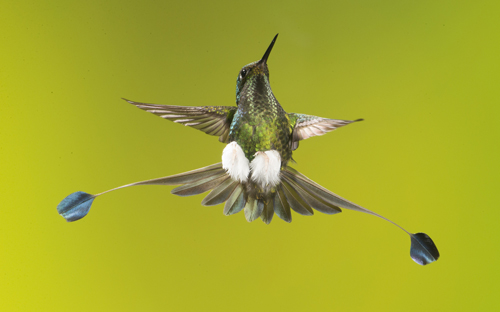
For almost as long as I've been photographing hummingbirds, well over twenty years for our Arizona Hummingbird and Bat Photo Shoots alone, I've longed to travel to Ecuador for the incredible hummingbirds found there. Several years ago I was fortunate to have met a few serious bird-watchers who had started up a birding lodge in the cloud forest mountains near Quito, Ecuador's capital, and I had been invited to visit. My schedule didn't allow me to at that time, and time passed and so, it seemed, did that opportunity.
While we were in India, however, we were contacted again, and this time, miraculously, I had some free time to visit. I was hosted by Tropical Birding, an absolutely world-class birding tour operator, and I spent six nights at their lodge. Fortunately, a good friend, Tom Wester, was free and joined me on the trip, making the experience even more pleasant as we bounced ideas around and shared the wonderful experience. Although I did my most rewarding flash work at the lodge we also did some set-ups at another, and photographed still more hummers with either flash or natural light at two other locations as well.
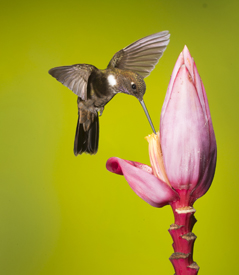
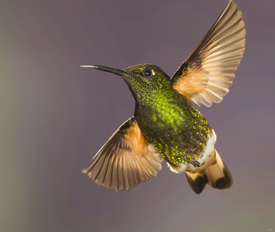
Brown Inca, Buff-tailed Coronet
The photography was without parallel. When I stepped onto the patio of the lodge for the first time I was literally surrounded by hummingbirds. A feeder flanked me on either side, and I faced two in front, and all of the feeders were literally swarming with birds. I'd been told that the problem wouldn't be getting hummingbird photos; the problem would be just getting one in the picture!
In all we saw and photographed 27 species of hummingbird, including what proved to be my favorite, the Booted Racquet-tailed Hummingbird seen above. This small, delicate and improbable-looking hummingbird buzzed along on wings that seemed too small for its body and long tail, almost drifting like a phantom ghost crane fly I see in our summer woods here at Hoot Hollow. The hummer, when displaying or attempting to intimidate, will spread its racquet tail wide, and puff out its white 'boots' in a wonderful display. I never tired of photographing them.
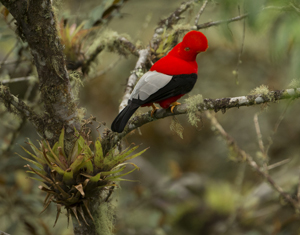 In addition to hummingbirds we also had colorful Tanagers of many species, and a bird I've always wanted to see, the glowing orange-red Cock-of-the-Rock, a mountain jungle bird with a head crest so large it appears to have no beak. I photographed a Red-rumped Toucanet, a brilliant but well-camouflaged green, large-billed bird, that, when motionless was nearly invisible among the leaves, and a bird that could sit so still that I was shooting images at 1/6th of a second for the greatest depth-of-field.
In addition to hummingbirds we also had colorful Tanagers of many species, and a bird I've always wanted to see, the glowing orange-red Cock-of-the-Rock, a mountain jungle bird with a head crest so large it appears to have no beak. I photographed a Red-rumped Toucanet, a brilliant but well-camouflaged green, large-billed bird, that, when motionless was nearly invisible among the leaves, and a bird that could sit so still that I was shooting images at 1/6th of a second for the greatest depth-of-field.
Perhaps my highlight, though, was seeing and photographing the most improbable and uniquely adapted of all the Hummingbirds, the Swordbill, with a long, slender beak that was as long, or longer, than its entire body. We saw several at our last location, which we'll visit again when we do our tour.
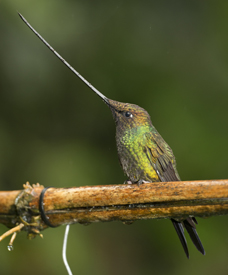
Next year, in March, I'll probably have back surgery but, if the Doc says it is OK, (and I'll know this at the end of May) we're planning on returning to Ecuador for our first Hummingbird Photo Tour in Ecuador. We'll have a small group of no more than 8, and like all of our hummingbird shoots only one photographer will be shooting at our sets at one time, and we'll have several sets.
If you're interested in joining us, contact our office immediately to get on the list -- we'll be confirming spots on a first-come basis. Here's the entire trip report:
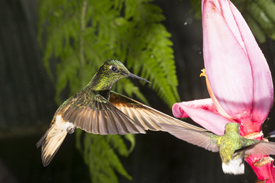
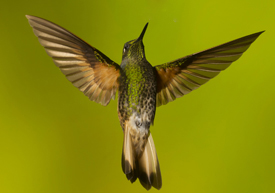
Buff-tailed Coronets
Day 1. Quito
We, Tom and I, arrived in Quito without event, flying from Pennsylvania to Atlanta for the 4.5 hour flight to Quito. The airport is located about 45 minutes from the town, but it was easy to get an official taxi at the airport counter, adjacent to the car rentals. We reached our hotel, the Hotel Sebastian, after 11PM, too late for a beer or food, but luckily Tom had some granola bars that held me over until morning.
Day 2. Quito to Tandayapa
After a cooked breakfast we met our host and guide, the owner of the Tandayapa lodge, and we headed northwest, taking the more scenic route that skirted active, but dormant and heavily vegetated, volcanoes, climbing to 9,000 feet or so before descending, on the Pacific, cloud forest side, to reach our lodge at 6,000 feet.
The ride was beautiful, even though some of this beauty was due to the tree lines demarcating various fields, and thus representing cleared out forest. A few colorful, scarlet-rumped and blackish tanagers flew across the road and into the undergrowth and, once, a large thrush wrestled a small mouse before us. None of us had ever seen a thrush with such large prey, as the bird acted more like a shrike, to which they’re distantly related.
Just outside the dining area of the lodge most of the feeders are located and we were amazed at the numbers, representing as many as 17 different species. Long-tailed hummers with racquet-tails, much like a drongo, sporting thick tufts of white thigh feathers were among the most common, but others that reminded me of Costa Rican species, like the bronze-tailed, and another, with a long blue tail, were among the most striking. I’m at a loss for names as of yet, all are too new, and I haven’t tried wading through the rather inferior guide book I brought along.
After a tour of the property we began to set up, and although we prepared I found I was still short on some critical items. I had carried along 4 mini-clamps to hold the photo backgrounds, when, really, 8 are better used for this. Much of my gear I packed in small, pint-sized ziplock bags, when big gallon bags would have worked for the gear and played double-duty in covering the flashes in the rain.
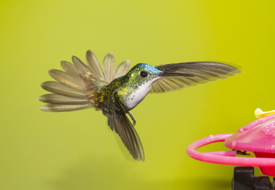 We began shooting shortly after lunch but it wasn’t long before the Pacific cloud/rain forest earned its name, and the lowering clouds, defining and then masking the surrounding ridges, brought an intermittent drizzle. We continued shooting through this, although many of the shots were poor as the flash froze the droplets into sparkly motes on the sensor, looking more like dust than anything else. By 2:45 the rain had intensified to the point where we worried about our gear, let alone our comfort, and we pulled the equipment into the dining area where, at 3:40 I’m writing this, hoping to get some more shooting in before dark.
We began shooting shortly after lunch but it wasn’t long before the Pacific cloud/rain forest earned its name, and the lowering clouds, defining and then masking the surrounding ridges, brought an intermittent drizzle. We continued shooting through this, although many of the shots were poor as the flash froze the droplets into sparkly motes on the sensor, looking more like dust than anything else. By 2:45 the rain had intensified to the point where we worried about our gear, let alone our comfort, and we pulled the equipment into the dining area where, at 3:40 I’m writing this, hoping to get some more shooting in before dark.
By 4 the rain had stopped and we shot until dark, our last shooting literally ‘in the dark,’ the light was so dim.
Day 3, Tandayapa Lodge
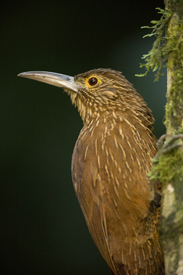 As directed yesterday Tom and I arose early and headed to the Hide where we hoped to photograph, or see, a Pitta, a ground-dwelling shy bird. We did not, although we did get the other ‘sure thing,’ a quail-dove, and a large, huge really, woodcreeper - a gigantic version of our own Brown Creeper from the US. We arrived long before sunrise and the forest was dark, so I cranked my ISO up to 16,000 for the images I made of the creeper. Two other birds, sadly unidentified with my poor knowledge of the SA jungle land birds, came in to the moth-feeder, where an electric light running overnight attracts moths and other insects for the morning birds.
As directed yesterday Tom and I arose early and headed to the Hide where we hoped to photograph, or see, a Pitta, a ground-dwelling shy bird. We did not, although we did get the other ‘sure thing,’ a quail-dove, and a large, huge really, woodcreeper - a gigantic version of our own Brown Creeper from the US. We arrived long before sunrise and the forest was dark, so I cranked my ISO up to 16,000 for the images I made of the creeper. Two other birds, sadly unidentified with my poor knowledge of the SA jungle land birds, came in to the moth-feeder, where an electric light running overnight attracts moths and other insects for the morning birds.
We spent the rest of the day at the hummingbird feeders, taking once again a 2PM break when another rain storm blew in. We started on the photo backgrounds, as these gave the cleanest, clearest backgrounds to offset the birds. Patrick, the lodge handyman, collected some flowers and we spent most of the shoot trying either to get the birds feeding from the flowers, or appearing to do so. There are so many birds here that we never had long to wait, even when some flowers, like those hanging straight down, offered nothing for the birds.
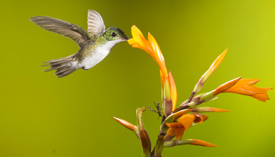
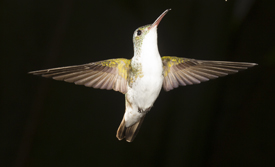
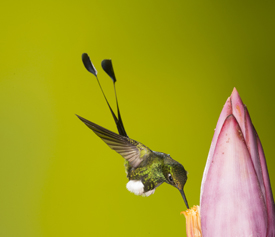
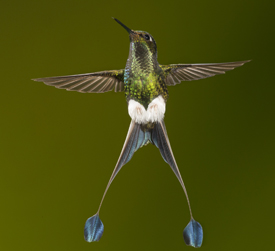
Above, top: Andean Emerald
Bottom: Booted Racquet-tailed Hummingbird
Stupidly, I flew down here with nearly 20 pounds still available for luggage, and now I wish I’d have brought some extra Plamps, a SYRINGE for dosing flowers, and extra articulating arms. Thin wire to direct the birds’ flight via a Plamp would be helpful, and perhaps even some light stands, although I have been using the six stands that are here. Although we’re getting along with what we have, I worry that I might break one of my feeding tubes, and bringing several extras would have been prudent.
Before the rain break I did rather traditional shooting, illuminating the photo background, but after the rains stopped, when, once again, we had to put up a banana leaf background, I tried several new backgrounds. These included ferns; underexposed, nearly completely black backgrounds, where I highlighted the birds with two back flashes, and even a close to over-exposed green background. We’ll see how these come out!
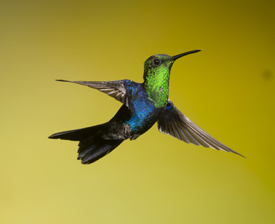
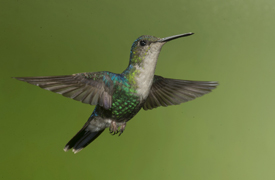
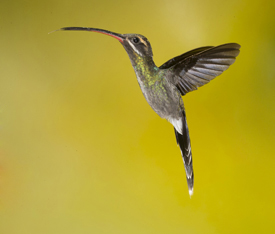

Top:
Green-crowned Woodnymph
Bottom:
White-whiskered Hermit; Brown Violet-ear (by Tom Wester)
Day 4. Milpe Reserve
We left our lodge after a 6AM breakfast for an hour drive to Milpe, about 2,500 feet lower in elevation. We set up two feeders and backgrounds, and wondered if the hummingbirds, accustomed to a large, dome-like feeder tube, would accept or recognize our feeder. A female Green-crowned Woodnymph did so almost immediately, and over the next hour or so other birds eventually did as well. By 10AM the feeders were active and we were shooting, getting Green-crowned Woodnymphs, Green-crowned Brilliants, Green Thorntails, and White-whiskered Hermits. A white-necked Jacobin male flew about but never visited the feeder.
Periodically we would place the big feeder by the set to give the birds some reinforcement, and eventually I decided to try some real hummer baseball, moving our background behind that feeder and positioning the flashes to
illuminate the
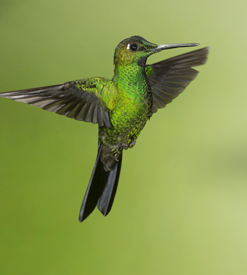
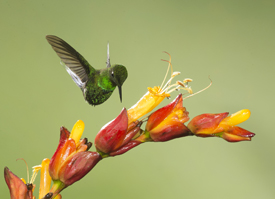
Green-crowned Brilliant; Green Thorntail
birds as they swarmed and swooped into the big feeder. I constricted the round base with leaves, so that the birds had to fly in from only one direction, but even then they had a three or four inch width, and obtaining critical focus was challenging. Especially so since most of the time we did ‘baseball,’ where we simply fired when we thought a bird flew over the plate,’ and like my skills in that sport, I struck out a lot! However we did get some interesting poses and flight shots that we’d have missed at our tube feeder.
By 3:30 clouds looked threatening so we packed and headed to a restaurant that I wanted to check out for possible lodging for this section of a future trip. The rooms were large and nice, and although the hummingbird activity was a bit slower than at Milpe, just a few miles away, the same species are there and the distance close enough that we could stay here and do both Milpe and the restaurant, which overlooked a beautiful expanse of a tropical river.
We reached the lodge by 5 and I set out our tube feeders again, and by 6 one was nearly empty. I refilled this, hoping to attract nectar-feeding bats that I half-suspected may have visited and drained my feeder overnight. Now, at 8PM, I’m done and going to bed, as we leave at 5AM tomorrow to visit a Cock-of-the-Rock lek about an hour’s drive from here.
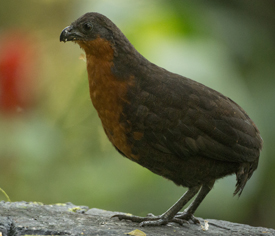 Day 5. I awoke at 4:10, did my exercises, and was out the door by 5 for an hour drive, most of which occurred on dirt roads with muddy pools and steep inclines, with forks where, if you didn’t know the way, you’d never get there. We arrived in the dull predawn light, with enough illumination that our headlamps were unnecessary, but barely so. We started almost immediately down a winding and increasingly steep trail, with a rope hand rail and squared off logs that functioned as steps. We expected a 300m hike, but it was much closer to 2/3rds of a mile.
Day 5. I awoke at 4:10, did my exercises, and was out the door by 5 for an hour drive, most of which occurred on dirt roads with muddy pools and steep inclines, with forks where, if you didn’t know the way, you’d never get there. We arrived in the dull predawn light, with enough illumination that our headlamps were unnecessary, but barely so. We started almost immediately down a winding and increasingly steep trail, with a rope hand rail and squared off logs that functioned as steps. We expected a 300m hike, but it was much closer to 2/3rds of a mile.
When we reached the lek a pavilion marked the observation area that overlooked an even steeper ravine where these brilliant orange birds, about the size of a large pigeon, perform. I expected more, as friends had been to a lek where they said they had birds all around them, and close. Our two birds (if indeed there were two) were shy, and flew up to barely visible perches just twice before flying off for good. They called repeatedly, a raspy trilling note, but apparently no females were about and there was little need for an energetic display.
The ranch owner and guide was enthusiastic and wished us to see the various specialties here, but since these birds are low jungle dwellers that would afford little chance for shots I passed, spending my time instead on shooting landscapes with my 70-300. I missed my 24-105 but left it back at the lodge, not wishing to carry any extra weight, and I’m glad I did, for we did walk a lot.
Eventually our guide, Jose’, and Tom joined me on the trail and we headed uphill where another observation area was located, this one for tanagers and toucanets, and a spectacular jay-sized toucan barbet. Climbing back out of the ravine was tough, although Jose’ grabbed my pack and I gladly let him, but by stopping a bit over mid-way the ascent wasn’t as bad as it could have been.
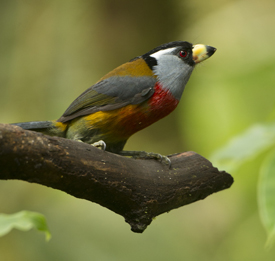
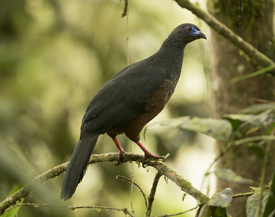
Toucan
Barbet, Sickle-winged Guan
Our ranch guide placed some chopped up bananas on a platform and within a few minutes the crimson-rumped toucanets arrived, followed soon after by the toucan barbets, and then a colorful blue-winged mountain tanager. I was particularly interested in the toucanets and raced around trying to get a decent image when, as it turned out about 2 hours later, the birds calmly posed and haste was not 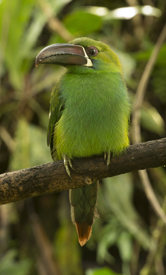 necessary. In fact, these birds can move so slow that 1/30th to 1/4th second exposures were possible, and I did many, locking up the camera mirror to avoid image-shake, and most of the time the bird simply froze in place. It’s easy to see why the birds can be over-looked when perched, their color is a perfect leaf-green and, when they are perched, their movements are truly sloth-like.
necessary. In fact, these birds can move so slow that 1/30th to 1/4th second exposures were possible, and I did many, locking up the camera mirror to avoid image-shake, and most of the time the bird simply froze in place. It’s easy to see why the birds can be over-looked when perched, their color is a perfect leaf-green and, when they are perched, their movements are truly sloth-like.
Other birds visited besides the two stars, including a huge White-throated Quail-dove that surprised me because, despite its size, it ate surprisingly little, just a banana slice or two, before flying off and later it was replaced by a stout, quail-like bird, the Dark-backed Wood-Quail that fed only feet away. Two species of rare mountain tanagers visited the feeder, the Black-chinned Mountain Tanager and the Blue-winged Tanager. Twice, a huge Sickle-winged Guan pair flew in, grabbing some bananas and moving off. The guans looked like a chachalaca, gray-bodied and nondescript and flying surprisingly high into a tree before moving along, finally reaching the feeder. We stayed at the feeder area for about two hours, passing on hiking out to see some Antbirds as the shooting here was too good to pass up.
This trail is not for anyone who is not willing to hike about 1.5 miles, downhill, knee-busting, and uphill, lung-busting, at 7,000 feet elevation.
The ranch had a feeder as well, and we spent about an hour watching the Hummers at the feeder, which included the following species, plus others I’d already seen. The new birds included: Speckled Hummer, brown with light spots on breast; Velvet-purple Coronet; Buff-tailed Coronet, with light buffy tail and golden shiny iridescence; and a truly spectacular bird, the Empress Brilliant, a blackish but really dark green bird with a yellowish belly which appears in one field guide as a bright evergreen with a light green belly, an illustration that I’d never match with the bird.
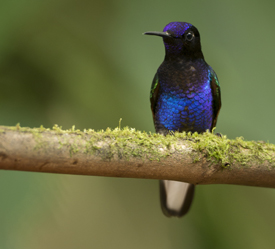
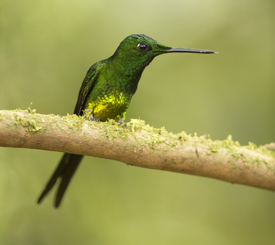
Velvet-purple Coronet, Empress Brilliant
Our hummingbird shooting and viewing was interrupted three times when a Plain-breasted Hawk, which in some references is considered a Sharp-shinned Hawk, blasted in, trying to catch a hummer. On its last pass it flew down the human trail and, if a bird was being chased, I’d suspect it was successful. Either way, it never reappeared.
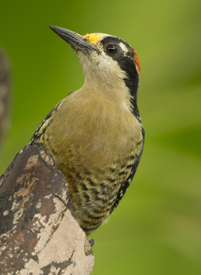
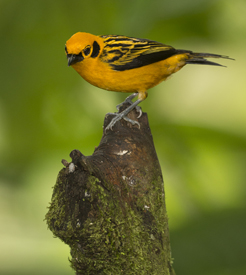
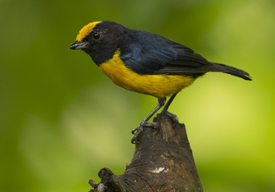
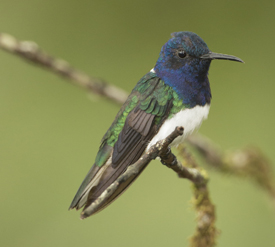
Top: Black-cheeked Woodpecker, Golden Tanager
Bottom: Orange-bellied Euphonia, White-necked Jacobin
We returned to the Restaurant from yesterday, this time to photograph the birds at the feeder, for a charge of $5 per head. Later we learned that for $8 we would have had lunch and the entrance fee included, but that we discovered on the drive back to the lodge. The shooting was good, with the following species: Orange-bellied Euphonia (with a blue chin) and Thick-billed Euphonia (with a golden crown); Golden Tanager, with a black ear patch; Silver-throated Tanager, with a light throat and long, black lines running down its back; Palm Tanager, a nondescript olive; the common Blue-gray Tanager; Lemon-rumped Tanager, and Black-cheeked Woodpecker. Banaquits and several hummingbirds, including white-necked jacobins and several brilliants, were around the feeders, and we shot those as well.
We returned to the lodge around 3:30, when we ate our packed picnic lunch and did some experimentation, shooting ambient light hummers with a back flash and one front flash. I was trying to balance a natural light background while still eliminating ghosting, and this worked best at around 1/125th of a second.
Towards dusk I set up a bat shoot, as the last two nights our tube feeders were emptied by, we suspect, nectar-feeding bats. Hopefully bats will fly in, but surprisingly, at 8PM, no bats have yet to arrive.
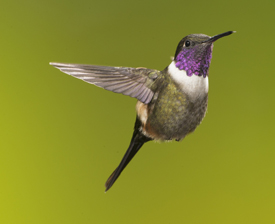
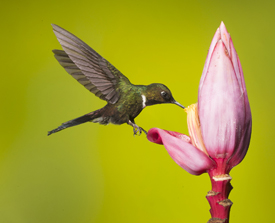
Purple-throated Woodstar, Gorgeted sunangel
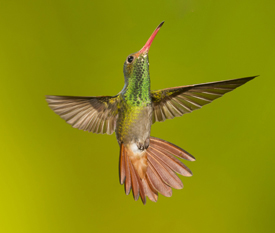
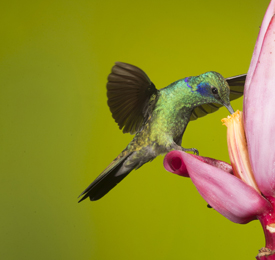
Rufous-tailed Hummingbird, Green Violet-ear
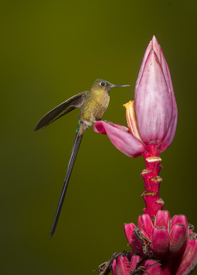
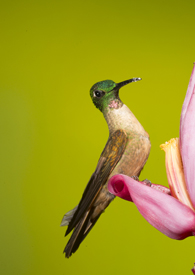
Violet-tailed Sylph, Fawn-breasted Brilliant
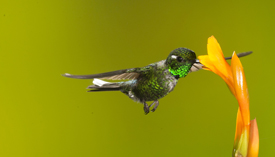
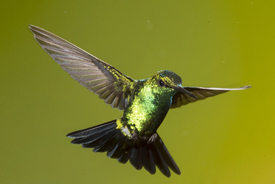
Purple-bibbed White-tip,
Western Emerald
Day 6. Tandayapa Lodge
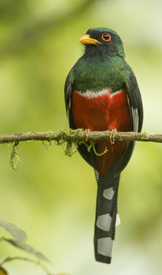 We stayed at the lodge for the majority of the day. Several times a Masked Trogan, a quiet, colorful bird quite easily overlooked, flew to the lodge and perched nearby, allowing a close approach. Tom worked on getting his images organized and identified, while I spent a frustrating hour getting a Range IR set up to photograph hummingbirds flying straight at the camera. Although it took a little while to get the distance correct, since a camera’s lag time must be accounted for after a bird trips the Range IR. Once done, I photographed the rest of the morning and afternoon remotely, while I worked on trying to do perched hummers, or organizing images as well.
We stayed at the lodge for the majority of the day. Several times a Masked Trogan, a quiet, colorful bird quite easily overlooked, flew to the lodge and perched nearby, allowing a close approach. Tom worked on getting his images organized and identified, while I spent a frustrating hour getting a Range IR set up to photograph hummingbirds flying straight at the camera. Although it took a little while to get the distance correct, since a camera’s lag time must be accounted for after a bird trips the Range IR. Once done, I photographed the rest of the morning and afternoon remotely, while I worked on trying to do perched hummers, or organizing images as well.
At 4 we headed down into the river valley where we followed the old Quito highway road to a spot where we hoped to find more Cock-of-the-Rocks. Our guide, Jose’, had seen birds there about three weeks earlier and, if the birds were present and on our side of the stream, we’d get shooting. The birds were there, calling and screeching, and whereas I described the call earlier, Jose’ more aptly described it, likening the call to a squealing pig, or, for me, nails being dragged across a blackboard. The birds flew back and forth across the canyon, pausing briefly a few times on a bromeliad-festooned tree where I managed some shots.
Day 7. The Lowland Jungle
We left at 5AM to drive 1.5 hours to a lodge that we hoped would be open that was great for tanagers. The owners had been vacationing in South Africa, but were supposed to be home by now, but were not, or at least they did not answer our calls.
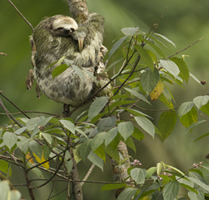
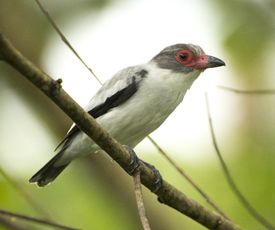
Three-toed Sloth, Masked Tityra
Our guides had an alternate plan, driving to a protected jungle preserve where we climbed a four story observation tower, hoping to photograph Aracaris and other birds in the treetops. Although we saw these long-billed birds none came close, although two rare endemics, an Orange-fronted Barbet and a slaty-throat Gnatcatcher, did fly about nearby, and a striking white bird, the Masked Tityra, flitted about as well. As we drove out and back towards the main road Jose’ had us stop and back up, as he thought he had seen a Three-toed Sloth. He had, about 70 yards away, and it was a fantastic sighting (for him to make!) and good shooting for us. The three toes of the forelimbs were clearly visible, as well as the distinctive and odd orange-colored patch on their back. The forequarters were truly green, covered with the algae and moss that typically grows on a sloth’s fur. It was an excellent sighting, and with the Swarovski scope we put on it to simply observe, it was even better.
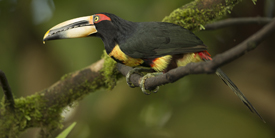 The observation tower time was fun, but not productive, and after an hour or so we drove back to the Restaurant birding area where we had drinks and I photographed a pale-billed aracari that visited the feeder.
The observation tower time was fun, but not productive, and after an hour or so we drove back to the Restaurant birding area where we had drinks and I photographed a pale-billed aracari that visited the feeder.
We took a different road home, driving across the high ridge country that towers above the main highway and our lodge, passing through beautiful cloud forests, marked by acacia-like umbrella trees, lichen and bromeliad-festooned trees and limbs, and prehistoric-looking tree ferns. We stopped at a few locations for photos, and this is a place I’d love to return to with a group for an afternoon of scenic photography. It was beautiful.
We arrived back at the lodge in time for a late lunch, after which we packed and 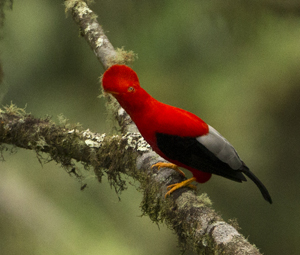 organized ourselves for our departure tomorrow to our last lodge, where we’ll spend the day photographing hummingbirds. It took us nearly two hours to just organize the gear, packing what we didn’t need and getting the rest ready for the commute to our last shooting destination.
organized ourselves for our departure tomorrow to our last lodge, where we’ll spend the day photographing hummingbirds. It took us nearly two hours to just organize the gear, packing what we didn’t need and getting the rest ready for the commute to our last shooting destination.
At 4 we headed back down for the Cock-of-the-Rocks where we did even better than yesterday, getting the birds in the open, if distance, two times. If the birds are here, this is a better location for these brilliant orange birds than the Paz de Aves location we were at two days ago.
Day 8. Guango
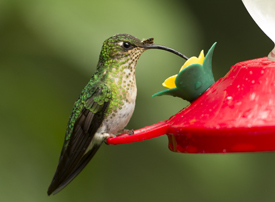
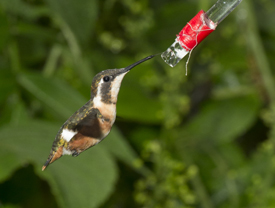
Mountain Velvetbreast, White-bellied Woodstar
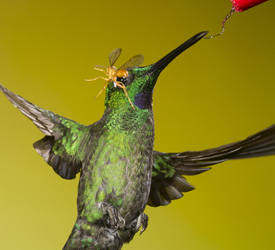
Green-crowned Brilliant and a Wasp in the way!
Our last full day in Ecuador, and a long one, with a flight out that evening at 11PM.
We left our lodge at 5:30AM for an hour and a half drive to Quito where we’d meet Jose’, and continue on over the eastern rim of the Andes, climbing to 14,000 feet before beginning a steep descent toward the Amazon basin. Our destination, Gaungo, was at 7,000 feet, still in the thick of the eastern cloud forest.
We passed through and over Coxia National Park where Spectacled Bears are occasionally seen, and it is easy to see why as the landscape is grassland and spongy, with no obscuring vegetation to hide a bear. Andean condors occasionally pass overhead, across an incredibly rugged mountain scape of steep cliffs, twisted canyons, and promontories and ridges that drifted off into the distance. Our views were compromised by rain and fog but what little we could see was enticing, and I’d like to include this area for a half-day scenic tour where, in addition to the landscape, we might have a chance at seeing a bear as well.
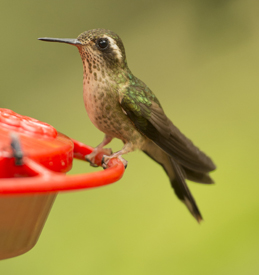
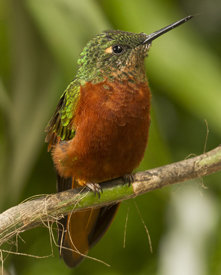
Speckled Hummingbird, Chestnut-breasted Coronet
Our last lodge was a short drive off the main road, marked by a colorful sign displaying the name and a large hummer. It was raining heavily and we chose to set up two feeders by the lodge entrance, under the shelter of a large roof. A crimson-breasted coronet hummingbird sat on a small branch just outside the porch, which we photographed as it perched, but neither this bird, nor any other, seemed interested in our new feeders.
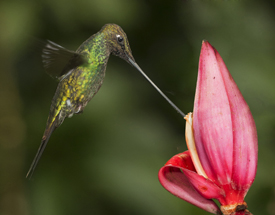 Other guests told us that the incredible Sword-billed Hummingbird was frequenting the other feeders, where a roofed viewing area would keep us out of the rain. We moved there, temporarily leaving our feeders at the porch, and soon the sword-bill arrived.
Other guests told us that the incredible Sword-billed Hummingbird was frequenting the other feeders, where a roofed viewing area would keep us out of the rain. We moved there, temporarily leaving our feeders at the porch, and soon the sword-bill arrived.
I usually don’t wax eloquently about the beauty or wonders of birds, but this one is truly a marvel of evolution. The long, thin bill is as long, or longer, than the birds entire body, and when perched, the bird must keep its head elevated, with the bill pointing to the sky. When feeding, the hummer either hovered over a platform feeder or, if perched, canted its head to drink from one of the ports off to the side. At a trumpet flower the hummer didn’t feed from below, as I expected, and insert its bill deep into the flower. Instead, it appeared to try to cheat and pierce the base of the flower to drink from the outside, although it did not appear successful. The bird visited often enough that we had multiple opportunities to photograph it perched or hovering above a platform feeder as it drank.
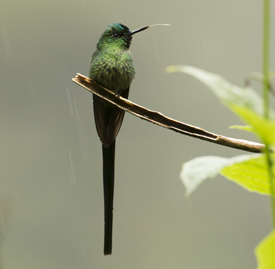 In all, we had six new species, and photographed all of them, including the striking Long-tailed Sylph, with vivid shiny purple tail feathers; Tourmaline Sunangels, so common but with an odd name we could never remember; tiny White-bellied Woodstars, that hovered like fat, slow bumblebees; Collared Incas, striking white and purple birds that soared in chase pursuits constantly around the feeders; Fawn-breasted Brilliants; tiny Tityra Metaltails, although I only saw one female; drab Speckled Hummingbirds; Mountain Velvetbreasts, with hermit-like curved bills; and one colorful songbird, a Masked Flowerpiercer, a vivid purple blue.
In all, we had six new species, and photographed all of them, including the striking Long-tailed Sylph, with vivid shiny purple tail feathers; Tourmaline Sunangels, so common but with an odd name we could never remember; tiny White-bellied Woodstars, that hovered like fat, slow bumblebees; Collared Incas, striking white and purple birds that soared in chase pursuits constantly around the feeders; Fawn-breasted Brilliants; tiny Tityra Metaltails, although I only saw one female; drab Speckled Hummingbirds; Mountain Velvetbreasts, with hermit-like curved bills; and one colorful songbird, a Masked Flowerpiercer, a vivid purple blue.
We set up four flashes on lightstands and controlled by radio slaves, so that Tom and I could shoot one set of two flashes without bothering the other set. By switching channels, either of us could quickly use the other set, allowing us to cover the entire feeder area. I moved my tube feeders to this area, and slowly, periodically, the Incas or Woodstars, and once, the sword-tail, would visit these feeders. Otherwise, we shot the birds as they perched on branches, or hovered around the platform feeders. This worked well, although I think that with two days here we’d get some birds visiting the flash set-ups, too.
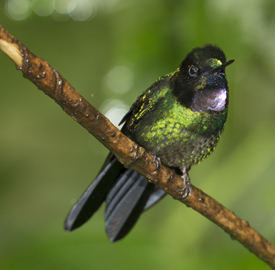
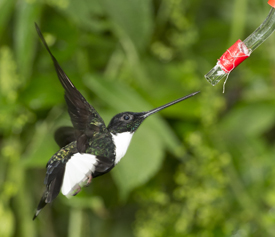
Tourmaline sunangel, Collared Inca
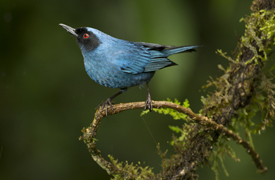
Masked Flowerpiercer
At 3 we broke the gear down, and because of time I passed on a chance to see or photograph Torrent Ducks, that were sitting on rocks in a nearby stream. Our gear was already wet, and I didn’t wish to pack up soaking wet gear for the long trip home.
By 4 we were off, arriving at the airport around 6, after a fruitless search for a restaurant in the nearby town, and settling on eating at the airport’s Johnny Rocket hamburger stand, which was quite good. We left Quito without incident, except for my being up-graded to business class, for the 5 hour flight back to Atlanta.
It was an excellent trip with a great guide and an even better Tour Operator, Tropical Birding, who I would recommend for anyone interested in bird-watching in most locations around the world. They truly do a first-class job, with boundless enthusiasm, and in reading their various trip reports, they really do their homework and produce tremendous sightings. We’ll be back as soon as we can, and I’ll be working on a brochure for the trip soon, and will have it posted.
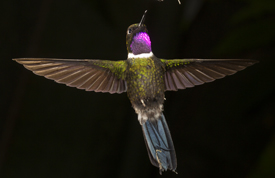
Purple-bibbed White-tip
Here is the trip report for our 2014 Ecuador Hummingbird Photo Tour
Visit our Trip and Scouting Report Pages for more images and an even better idea of what our trips are like. There you'll find our archived reports from previous years.
Scouting Trip Report:
Hummingbirds of Ecuador 2013
Until our brochure is posted for 2015,
please use this as a reference. Except for
dates and price, and a 'polish' not available
on a scouting trip, the details will be similar.

For almost as long as I've been photographing hummingbirds, well over twenty years for our Arizona Hummingbird and Bat Photo Shoots alone, I've longed to travel to Ecuador for the incredible hummingbirds found there. Several years ago I was fortunate to have met a few serious bird-watchers who had started up a birding lodge in the cloud forest mountains near Quito, Ecuador's capital, and I had been invited to visit. My schedule didn't allow me to at that time, and time passed and so, it seemed, did that opportunity.
While we were in India, however, we were contacted again, and this time, miraculously, I had some free time to visit. I was hosted by Tropical Birding, an absolutely world-class birding tour operator, and I spent six nights at their lodge. Fortunately, a good friend, Tom Wester, was free and joined me on the trip, making the experience even more pleasant as we bounced ideas around and shared the wonderful experience. Although I did my most rewarding flash work at the lodge we also did some set-ups at another, and photographed still more hummers with either flash or natural light at two other locations as well.


Brown Inca, Buff-tailed Coronet
The photography was without parallel. When I stepped onto the patio of the lodge for the first time I was literally surrounded by hummingbirds. A feeder flanked me on either side, and I faced two in front, and all of the feeders were literally swarming with birds. I'd been told that the problem wouldn't be getting hummingbird photos; the problem would be just getting one in the picture!
In all we saw and photographed 27 species of hummingbird, including what proved to be my favorite, the Booted Racquet-tailed Hummingbird seen above. This small, delicate and improbable-looking hummingbird buzzed along on wings that seemed too small for its body and long tail, almost drifting like a phantom ghost crane fly I see in our summer woods here at Hoot Hollow. The hummer, when displaying or attempting to intimidate, will spread its racquet tail wide, and puff out its white 'boots' in a wonderful display. I never tired of photographing them.
 In addition to hummingbirds we also had colorful Tanagers of many species, and a bird I've always wanted to see, the glowing orange-red Cock-of-the-Rock, a mountain jungle bird with a head crest so large it appears to have no beak. I photographed a Red-rumped Toucanet, a brilliant but well-camouflaged green, large-billed bird, that, when motionless was nearly invisible among the leaves, and a bird that could sit so still that I was shooting images at 1/6th of a second for the greatest depth-of-field.
In addition to hummingbirds we also had colorful Tanagers of many species, and a bird I've always wanted to see, the glowing orange-red Cock-of-the-Rock, a mountain jungle bird with a head crest so large it appears to have no beak. I photographed a Red-rumped Toucanet, a brilliant but well-camouflaged green, large-billed bird, that, when motionless was nearly invisible among the leaves, and a bird that could sit so still that I was shooting images at 1/6th of a second for the greatest depth-of-field.
Perhaps my highlight, though, was seeing and photographing the most improbable and uniquely adapted of all the Hummingbirds, the Swordbill, with a long, slender beak that was as long, or longer, than its entire body. We saw several at our last location, which we'll visit again when we do our tour.

Next year, in March, I'll probably have back surgery but, if the Doc says it is OK, (and I'll know this at the end of May) we're planning on returning to Ecuador for our first Hummingbird Photo Tour in Ecuador. We'll have a small group of no more than 8, and like all of our hummingbird shoots only one photographer will be shooting at our sets at one time, and we'll have several sets.
If you're interested in joining us, contact our office immediately to get on the list -- we'll be confirming spots on a first-come basis. Here's the entire trip report:


Buff-tailed Coronets
Day 1. Quito
We, Tom and I, arrived in Quito without event, flying from Pennsylvania to Atlanta for the 4.5 hour flight to Quito. The airport is located about 45 minutes from the town, but it was easy to get an official taxi at the airport counter, adjacent to the car rentals. We reached our hotel, the Hotel Sebastian, after 11PM, too late for a beer or food, but luckily Tom had some granola bars that held me over until morning.
Day 2. Quito to Tandayapa
After a cooked breakfast we met our host and guide, the owner of the Tandayapa lodge, and we headed northwest, taking the more scenic route that skirted active, but dormant and heavily vegetated, volcanoes, climbing to 9,000 feet or so before descending, on the Pacific, cloud forest side, to reach our lodge at 6,000 feet.
The ride was beautiful, even though some of this beauty was due to the tree lines demarcating various fields, and thus representing cleared out forest. A few colorful, scarlet-rumped and blackish tanagers flew across the road and into the undergrowth and, once, a large thrush wrestled a small mouse before us. None of us had ever seen a thrush with such large prey, as the bird acted more like a shrike, to which they’re distantly related.
Just outside the dining area of the lodge most of the feeders are located and we were amazed at the numbers, representing as many as 17 different species. Long-tailed hummers with racquet-tails, much like a drongo, sporting thick tufts of white thigh feathers were among the most common, but others that reminded me of Costa Rican species, like the bronze-tailed, and another, with a long blue tail, were among the most striking. I’m at a loss for names as of yet, all are too new, and I haven’t tried wading through the rather inferior guide book I brought along.
After a tour of the property we began to set up, and although we prepared I found I was still short on some critical items. I had carried along 4 mini-clamps to hold the photo backgrounds, when, really, 8 are better used for this. Much of my gear I packed in small, pint-sized ziplock bags, when big gallon bags would have worked for the gear and played double-duty in covering the flashes in the rain.
 We began shooting shortly after lunch but it wasn’t long before the Pacific cloud/rain forest earned its name, and the lowering clouds, defining and then masking the surrounding ridges, brought an intermittent drizzle. We continued shooting through this, although many of the shots were poor as the flash froze the droplets into sparkly motes on the sensor, looking more like dust than anything else. By 2:45 the rain had intensified to the point where we worried about our gear, let alone our comfort, and we pulled the equipment into the dining area where, at 3:40 I’m writing this, hoping to get some more shooting in before dark.
We began shooting shortly after lunch but it wasn’t long before the Pacific cloud/rain forest earned its name, and the lowering clouds, defining and then masking the surrounding ridges, brought an intermittent drizzle. We continued shooting through this, although many of the shots were poor as the flash froze the droplets into sparkly motes on the sensor, looking more like dust than anything else. By 2:45 the rain had intensified to the point where we worried about our gear, let alone our comfort, and we pulled the equipment into the dining area where, at 3:40 I’m writing this, hoping to get some more shooting in before dark.
By 4 the rain had stopped and we shot until dark, our last shooting literally ‘in the dark,’ the light was so dim.
Day 3, Tandayapa Lodge
 As directed yesterday Tom and I arose early and headed to the Hide where we hoped to photograph, or see, a Pitta, a ground-dwelling shy bird. We did not, although we did get the other ‘sure thing,’ a quail-dove, and a large, huge really, woodcreeper - a gigantic version of our own Brown Creeper from the US. We arrived long before sunrise and the forest was dark, so I cranked my ISO up to 16,000 for the images I made of the creeper. Two other birds, sadly unidentified with my poor knowledge of the SA jungle land birds, came in to the moth-feeder, where an electric light running overnight attracts moths and other insects for the morning birds.
As directed yesterday Tom and I arose early and headed to the Hide where we hoped to photograph, or see, a Pitta, a ground-dwelling shy bird. We did not, although we did get the other ‘sure thing,’ a quail-dove, and a large, huge really, woodcreeper - a gigantic version of our own Brown Creeper from the US. We arrived long before sunrise and the forest was dark, so I cranked my ISO up to 16,000 for the images I made of the creeper. Two other birds, sadly unidentified with my poor knowledge of the SA jungle land birds, came in to the moth-feeder, where an electric light running overnight attracts moths and other insects for the morning birds.
We spent the rest of the day at the hummingbird feeders, taking once again a 2PM break when another rain storm blew in. We started on the photo backgrounds, as these gave the cleanest, clearest backgrounds to offset the birds. Patrick, the lodge handyman, collected some flowers and we spent most of the shoot trying either to get the birds feeding from the flowers, or appearing to do so. There are so many birds here that we never had long to wait, even when some flowers, like those hanging straight down, offered nothing for the birds.




Above, top: Andean Emerald
Bottom: Booted Racquet-tailed Hummingbird
Stupidly, I flew down here with nearly 20 pounds still available for luggage, and now I wish I’d have brought some extra Plamps, a SYRINGE for dosing flowers, and extra articulating arms. Thin wire to direct the birds’ flight via a Plamp would be helpful, and perhaps even some light stands, although I have been using the six stands that are here. Although we’re getting along with what we have, I worry that I might break one of my feeding tubes, and bringing several extras would have been prudent.
Before the rain break I did rather traditional shooting, illuminating the photo background, but after the rains stopped, when, once again, we had to put up a banana leaf background, I tried several new backgrounds. These included ferns; underexposed, nearly completely black backgrounds, where I highlighted the birds with two back flashes, and even a close to over-exposed green background. We’ll see how these come out!




Top:
Green-crowned Woodnymph
Bottom:
White-whiskered Hermit; Brown Violet-ear (by Tom Wester)
Day 4. Milpe Reserve
We left our lodge after a 6AM breakfast for an hour drive to Milpe, about 2,500 feet lower in elevation. We set up two feeders and backgrounds, and wondered if the hummingbirds, accustomed to a large, dome-like feeder tube, would accept or recognize our feeder. A female Green-crowned Woodnymph did so almost immediately, and over the next hour or so other birds eventually did as well. By 10AM the feeders were active and we were shooting, getting Green-crowned Woodnymphs, Green-crowned Brilliants, Green Thorntails, and White-whiskered Hermits. A white-necked Jacobin male flew about but never visited the feeder.
Periodically we would place the big feeder by the set to give the birds some reinforcement, and eventually I decided to try some real hummer baseball, moving our background behind that feeder and positioning the flashes to
illuminate the


Green-crowned Brilliant; Green Thorntail
birds as they swarmed and swooped into the big feeder. I constricted the round base with leaves, so that the birds had to fly in from only one direction, but even then they had a three or four inch width, and obtaining critical focus was challenging. Especially so since most of the time we did ‘baseball,’ where we simply fired when we thought a bird flew over the plate,’ and like my skills in that sport, I struck out a lot! However we did get some interesting poses and flight shots that we’d have missed at our tube feeder.
By 3:30 clouds looked threatening so we packed and headed to a restaurant that I wanted to check out for possible lodging for this section of a future trip. The rooms were large and nice, and although the hummingbird activity was a bit slower than at Milpe, just a few miles away, the same species are there and the distance close enough that we could stay here and do both Milpe and the restaurant, which overlooked a beautiful expanse of a tropical river.
We reached the lodge by 5 and I set out our tube feeders again, and by 6 one was nearly empty. I refilled this, hoping to attract nectar-feeding bats that I half-suspected may have visited and drained my feeder overnight. Now, at 8PM, I’m done and going to bed, as we leave at 5AM tomorrow to visit a Cock-of-the-Rock lek about an hour’s drive from here.
 Day 5. I awoke at 4:10, did my exercises, and was out the door by 5 for an hour drive, most of which occurred on dirt roads with muddy pools and steep inclines, with forks where, if you didn’t know the way, you’d never get there. We arrived in the dull predawn light, with enough illumination that our headlamps were unnecessary, but barely so. We started almost immediately down a winding and increasingly steep trail, with a rope hand rail and squared off logs that functioned as steps. We expected a 300m hike, but it was much closer to 2/3rds of a mile.
Day 5. I awoke at 4:10, did my exercises, and was out the door by 5 for an hour drive, most of which occurred on dirt roads with muddy pools and steep inclines, with forks where, if you didn’t know the way, you’d never get there. We arrived in the dull predawn light, with enough illumination that our headlamps were unnecessary, but barely so. We started almost immediately down a winding and increasingly steep trail, with a rope hand rail and squared off logs that functioned as steps. We expected a 300m hike, but it was much closer to 2/3rds of a mile.
When we reached the lek a pavilion marked the observation area that overlooked an even steeper ravine where these brilliant orange birds, about the size of a large pigeon, perform. I expected more, as friends had been to a lek where they said they had birds all around them, and close. Our two birds (if indeed there were two) were shy, and flew up to barely visible perches just twice before flying off for good. They called repeatedly, a raspy trilling note, but apparently no females were about and there was little need for an energetic display.
The ranch owner and guide was enthusiastic and wished us to see the various specialties here, but since these birds are low jungle dwellers that would afford little chance for shots I passed, spending my time instead on shooting landscapes with my 70-300. I missed my 24-105 but left it back at the lodge, not wishing to carry any extra weight, and I’m glad I did, for we did walk a lot.
Eventually our guide, Jose’, and Tom joined me on the trail and we headed uphill where another observation area was located, this one for tanagers and toucanets, and a spectacular jay-sized toucan barbet. Climbing back out of the ravine was tough, although Jose’ grabbed my pack and I gladly let him, but by stopping a bit over mid-way the ascent wasn’t as bad as it could have been.


Toucan
Barbet, Sickle-winged Guan
Our ranch guide placed some chopped up bananas on a platform and within a few minutes the crimson-rumped toucanets arrived, followed soon after by the toucan barbets, and then a colorful blue-winged mountain tanager. I was particularly interested in the toucanets and raced around trying to get a decent image when, as it turned out about 2 hours later, the birds calmly posed and haste was not  necessary. In fact, these birds can move so slow that 1/30th to 1/4th second exposures were possible, and I did many, locking up the camera mirror to avoid image-shake, and most of the time the bird simply froze in place. It’s easy to see why the birds can be over-looked when perched, their color is a perfect leaf-green and, when they are perched, their movements are truly sloth-like.
necessary. In fact, these birds can move so slow that 1/30th to 1/4th second exposures were possible, and I did many, locking up the camera mirror to avoid image-shake, and most of the time the bird simply froze in place. It’s easy to see why the birds can be over-looked when perched, their color is a perfect leaf-green and, when they are perched, their movements are truly sloth-like.
Other birds visited besides the two stars, including a huge White-throated Quail-dove that surprised me because, despite its size, it ate surprisingly little, just a banana slice or two, before flying off and later it was replaced by a stout, quail-like bird, the Dark-backed Wood-Quail that fed only feet away. Two species of rare mountain tanagers visited the feeder, the Black-chinned Mountain Tanager and the Blue-winged Tanager. Twice, a huge Sickle-winged Guan pair flew in, grabbing some bananas and moving off. The guans looked like a chachalaca, gray-bodied and nondescript and flying surprisingly high into a tree before moving along, finally reaching the feeder. We stayed at the feeder area for about two hours, passing on hiking out to see some Antbirds as the shooting here was too good to pass up.
This trail is not for anyone who is not willing to hike about 1.5 miles, downhill, knee-busting, and uphill, lung-busting, at 7,000 feet elevation.
The ranch had a feeder as well, and we spent about an hour watching the Hummers at the feeder, which included the following species, plus others I’d already seen. The new birds included: Speckled Hummer, brown with light spots on breast; Velvet-purple Coronet; Buff-tailed Coronet, with light buffy tail and golden shiny iridescence; and a truly spectacular bird, the Empress Brilliant, a blackish but really dark green bird with a yellowish belly which appears in one field guide as a bright evergreen with a light green belly, an illustration that I’d never match with the bird.


Velvet-purple Coronet, Empress Brilliant
Our hummingbird shooting and viewing was interrupted three times when a Plain-breasted Hawk, which in some references is considered a Sharp-shinned Hawk, blasted in, trying to catch a hummer. On its last pass it flew down the human trail and, if a bird was being chased, I’d suspect it was successful. Either way, it never reappeared.




Top: Black-cheeked Woodpecker, Golden Tanager
Bottom: Orange-bellied Euphonia, White-necked Jacobin
We returned to the Restaurant from yesterday, this time to photograph the birds at the feeder, for a charge of $5 per head. Later we learned that for $8 we would have had lunch and the entrance fee included, but that we discovered on the drive back to the lodge. The shooting was good, with the following species: Orange-bellied Euphonia (with a blue chin) and Thick-billed Euphonia (with a golden crown); Golden Tanager, with a black ear patch; Silver-throated Tanager, with a light throat and long, black lines running down its back; Palm Tanager, a nondescript olive; the common Blue-gray Tanager; Lemon-rumped Tanager, and Black-cheeked Woodpecker. Banaquits and several hummingbirds, including white-necked jacobins and several brilliants, were around the feeders, and we shot those as well.
We returned to the lodge around 3:30, when we ate our packed picnic lunch and did some experimentation, shooting ambient light hummers with a back flash and one front flash. I was trying to balance a natural light background while still eliminating ghosting, and this worked best at around 1/125th of a second.
Towards dusk I set up a bat shoot, as the last two nights our tube feeders were emptied by, we suspect, nectar-feeding bats. Hopefully bats will fly in, but surprisingly, at 8PM, no bats have yet to arrive.


Purple-throated Woodstar, Gorgeted sunangel


Rufous-tailed Hummingbird, Green Violet-ear


Violet-tailed Sylph, Fawn-breasted Brilliant


Purple-bibbed White-tip,
Western Emerald
Day 6. Tandayapa Lodge
 We stayed at the lodge for the majority of the day. Several times a Masked Trogan, a quiet, colorful bird quite easily overlooked, flew to the lodge and perched nearby, allowing a close approach. Tom worked on getting his images organized and identified, while I spent a frustrating hour getting a Range IR set up to photograph hummingbirds flying straight at the camera. Although it took a little while to get the distance correct, since a camera’s lag time must be accounted for after a bird trips the Range IR. Once done, I photographed the rest of the morning and afternoon remotely, while I worked on trying to do perched hummers, or organizing images as well.
We stayed at the lodge for the majority of the day. Several times a Masked Trogan, a quiet, colorful bird quite easily overlooked, flew to the lodge and perched nearby, allowing a close approach. Tom worked on getting his images organized and identified, while I spent a frustrating hour getting a Range IR set up to photograph hummingbirds flying straight at the camera. Although it took a little while to get the distance correct, since a camera’s lag time must be accounted for after a bird trips the Range IR. Once done, I photographed the rest of the morning and afternoon remotely, while I worked on trying to do perched hummers, or organizing images as well.
At 4 we headed down into the river valley where we followed the old Quito highway road to a spot where we hoped to find more Cock-of-the-Rocks. Our guide, Jose’, had seen birds there about three weeks earlier and, if the birds were present and on our side of the stream, we’d get shooting. The birds were there, calling and screeching, and whereas I described the call earlier, Jose’ more aptly described it, likening the call to a squealing pig, or, for me, nails being dragged across a blackboard. The birds flew back and forth across the canyon, pausing briefly a few times on a bromeliad-festooned tree where I managed some shots.
Day 7. The Lowland Jungle
We left at 5AM to drive 1.5 hours to a lodge that we hoped would be open that was great for tanagers. The owners had been vacationing in South Africa, but were supposed to be home by now, but were not, or at least they did not answer our calls.


Three-toed Sloth, Masked Tityra
Our guides had an alternate plan, driving to a protected jungle preserve where we climbed a four story observation tower, hoping to photograph Aracaris and other birds in the treetops. Although we saw these long-billed birds none came close, although two rare endemics, an Orange-fronted Barbet and a slaty-throat Gnatcatcher, did fly about nearby, and a striking white bird, the Masked Tityra, flitted about as well. As we drove out and back towards the main road Jose’ had us stop and back up, as he thought he had seen a Three-toed Sloth. He had, about 70 yards away, and it was a fantastic sighting (for him to make!) and good shooting for us. The three toes of the forelimbs were clearly visible, as well as the distinctive and odd orange-colored patch on their back. The forequarters were truly green, covered with the algae and moss that typically grows on a sloth’s fur. It was an excellent sighting, and with the Swarovski scope we put on it to simply observe, it was even better.
 The observation tower time was fun, but not productive, and after an hour or so we drove back to the Restaurant birding area where we had drinks and I photographed a pale-billed aracari that visited the feeder.
The observation tower time was fun, but not productive, and after an hour or so we drove back to the Restaurant birding area where we had drinks and I photographed a pale-billed aracari that visited the feeder.
We took a different road home, driving across the high ridge country that towers above the main highway and our lodge, passing through beautiful cloud forests, marked by acacia-like umbrella trees, lichen and bromeliad-festooned trees and limbs, and prehistoric-looking tree ferns. We stopped at a few locations for photos, and this is a place I’d love to return to with a group for an afternoon of scenic photography. It was beautiful.
We arrived back at the lodge in time for a late lunch, after which we packed and  organized ourselves for our departure tomorrow to our last lodge, where we’ll spend the day photographing hummingbirds. It took us nearly two hours to just organize the gear, packing what we didn’t need and getting the rest ready for the commute to our last shooting destination.
organized ourselves for our departure tomorrow to our last lodge, where we’ll spend the day photographing hummingbirds. It took us nearly two hours to just organize the gear, packing what we didn’t need and getting the rest ready for the commute to our last shooting destination.
At 4 we headed back down for the Cock-of-the-Rocks where we did even better than yesterday, getting the birds in the open, if distance, two times. If the birds are here, this is a better location for these brilliant orange birds than the Paz de Aves location we were at two days ago.
Day 8. Guango


Mountain Velvetbreast, White-bellied Woodstar

Green-crowned Brilliant and a Wasp in the way!
Our last full day in Ecuador, and a long one, with a flight out that evening at 11PM.
We left our lodge at 5:30AM for an hour and a half drive to Quito where we’d meet Jose’, and continue on over the eastern rim of the Andes, climbing to 14,000 feet before beginning a steep descent toward the Amazon basin. Our destination, Gaungo, was at 7,000 feet, still in the thick of the eastern cloud forest.
We passed through and over Coxia National Park where Spectacled Bears are occasionally seen, and it is easy to see why as the landscape is grassland and spongy, with no obscuring vegetation to hide a bear. Andean condors occasionally pass overhead, across an incredibly rugged mountain scape of steep cliffs, twisted canyons, and promontories and ridges that drifted off into the distance. Our views were compromised by rain and fog but what little we could see was enticing, and I’d like to include this area for a half-day scenic tour where, in addition to the landscape, we might have a chance at seeing a bear as well.


Speckled Hummingbird, Chestnut-breasted Coronet
Our last lodge was a short drive off the main road, marked by a colorful sign displaying the name and a large hummer. It was raining heavily and we chose to set up two feeders by the lodge entrance, under the shelter of a large roof. A crimson-breasted coronet hummingbird sat on a small branch just outside the porch, which we photographed as it perched, but neither this bird, nor any other, seemed interested in our new feeders.
 Other guests told us that the incredible Sword-billed Hummingbird was frequenting the other feeders, where a roofed viewing area would keep us out of the rain. We moved there, temporarily leaving our feeders at the porch, and soon the sword-bill arrived.
Other guests told us that the incredible Sword-billed Hummingbird was frequenting the other feeders, where a roofed viewing area would keep us out of the rain. We moved there, temporarily leaving our feeders at the porch, and soon the sword-bill arrived.
I usually don’t wax eloquently about the beauty or wonders of birds, but this one is truly a marvel of evolution. The long, thin bill is as long, or longer, than the birds entire body, and when perched, the bird must keep its head elevated, with the bill pointing to the sky. When feeding, the hummer either hovered over a platform feeder or, if perched, canted its head to drink from one of the ports off to the side. At a trumpet flower the hummer didn’t feed from below, as I expected, and insert its bill deep into the flower. Instead, it appeared to try to cheat and pierce the base of the flower to drink from the outside, although it did not appear successful. The bird visited often enough that we had multiple opportunities to photograph it perched or hovering above a platform feeder as it drank.
 In all, we had six new species, and photographed all of them, including the striking Long-tailed Sylph, with vivid shiny purple tail feathers; Tourmaline Sunangels, so common but with an odd name we could never remember; tiny White-bellied Woodstars, that hovered like fat, slow bumblebees; Collared Incas, striking white and purple birds that soared in chase pursuits constantly around the feeders; Fawn-breasted Brilliants; tiny Tityra Metaltails, although I only saw one female; drab Speckled Hummingbirds; Mountain Velvetbreasts, with hermit-like curved bills; and one colorful songbird, a Masked Flowerpiercer, a vivid purple blue.
In all, we had six new species, and photographed all of them, including the striking Long-tailed Sylph, with vivid shiny purple tail feathers; Tourmaline Sunangels, so common but with an odd name we could never remember; tiny White-bellied Woodstars, that hovered like fat, slow bumblebees; Collared Incas, striking white and purple birds that soared in chase pursuits constantly around the feeders; Fawn-breasted Brilliants; tiny Tityra Metaltails, although I only saw one female; drab Speckled Hummingbirds; Mountain Velvetbreasts, with hermit-like curved bills; and one colorful songbird, a Masked Flowerpiercer, a vivid purple blue.
We set up four flashes on lightstands and controlled by radio slaves, so that Tom and I could shoot one set of two flashes without bothering the other set. By switching channels, either of us could quickly use the other set, allowing us to cover the entire feeder area. I moved my tube feeders to this area, and slowly, periodically, the Incas or Woodstars, and once, the sword-tail, would visit these feeders. Otherwise, we shot the birds as they perched on branches, or hovered around the platform feeders. This worked well, although I think that with two days here we’d get some birds visiting the flash set-ups, too.


Tourmaline sunangel, Collared Inca

Masked Flowerpiercer
At 3 we broke the gear down, and because of time I passed on a chance to see or photograph Torrent Ducks, that were sitting on rocks in a nearby stream. Our gear was already wet, and I didn’t wish to pack up soaking wet gear for the long trip home.
By 4 we were off, arriving at the airport around 6, after a fruitless search for a restaurant in the nearby town, and settling on eating at the airport’s Johnny Rocket hamburger stand, which was quite good. We left Quito without incident, except for my being up-graded to business class, for the 5 hour flight back to Atlanta.
It was an excellent trip with a great guide and an even better Tour Operator, Tropical Birding, who I would recommend for anyone interested in bird-watching in most locations around the world. They truly do a first-class job, with boundless enthusiasm, and in reading their various trip reports, they really do their homework and produce tremendous sightings. We’ll be back as soon as we can, and I’ll be working on a brochure for the trip soon, and will have it posted.

Purple-bibbed White-tip
Here is the trip report for our 2014 Ecuador Hummingbird Photo Tour
Visit our Trip and Scouting Report Pages for more images and an even better idea of what our trips are like. There you'll find our archived reports from previous years.
Scouting Trip Report:
Hummingbirds of Ecuador 2013
Until our brochure is posted for 2015,
please use this as a reference. Except for
dates and price, and a 'polish' not available
on a scouting trip, the details will be similar.

For almost as long as I've been photographing hummingbirds, well over twenty years for our Arizona Hummingbird and Bat Photo Shoots alone, I've longed to travel to Ecuador for the incredible hummingbirds found there. Several years ago I was fortunate to have met a few serious bird-watchers who had started up a birding lodge in the cloud forest mountains near Quito, Ecuador's capital, and I had been invited to visit. My schedule didn't allow me to at that time, and time passed and so, it seemed, did that opportunity.
While we were in India, however, we were contacted again, and this time, miraculously, I had some free time to visit. I was hosted by Tropical Birding, an absolutely world-class birding tour operator, and I spent six nights at their lodge. Fortunately, a good friend, Tom Wester, was free and joined me on the trip, making the experience even more pleasant as we bounced ideas around and shared the wonderful experience. Although I did my most rewarding flash work at the lodge we also did some set-ups at another, and photographed still more hummers with either flash or natural light at two other locations as well.


Brown Inca, Buff-tailed Coronet
The photography was without parallel. When I stepped onto the patio of the lodge for the first time I was literally surrounded by hummingbirds. A feeder flanked me on either side, and I faced two in front, and all of the feeders were literally swarming with birds. I'd been told that the problem wouldn't be getting hummingbird photos; the problem would be just getting one in the picture!
In all we saw and photographed 27 species of hummingbird, including what proved to be my favorite, the Booted Racquet-tailed Hummingbird seen above. This small, delicate and improbable-looking hummingbird buzzed along on wings that seemed too small for its body and long tail, almost drifting like a phantom ghost crane fly I see in our summer woods here at Hoot Hollow. The hummer, when displaying or attempting to intimidate, will spread its racquet tail wide, and puff out its white 'boots' in a wonderful display. I never tired of photographing them.
 In addition to hummingbirds we also had colorful Tanagers of many species, and a bird I've always wanted to see, the glowing orange-red Cock-of-the-Rock, a mountain jungle bird with a head crest so large it appears to have no beak. I photographed a Red-rumped Toucanet, a brilliant but well-camouflaged green, large-billed bird, that, when motionless was nearly invisible among the leaves, and a bird that could sit so still that I was shooting images at 1/6th of a second for the greatest depth-of-field.
In addition to hummingbirds we also had colorful Tanagers of many species, and a bird I've always wanted to see, the glowing orange-red Cock-of-the-Rock, a mountain jungle bird with a head crest so large it appears to have no beak. I photographed a Red-rumped Toucanet, a brilliant but well-camouflaged green, large-billed bird, that, when motionless was nearly invisible among the leaves, and a bird that could sit so still that I was shooting images at 1/6th of a second for the greatest depth-of-field.
Perhaps my highlight, though, was seeing and photographing the most improbable and uniquely adapted of all the Hummingbirds, the Swordbill, with a long, slender beak that was as long, or longer, than its entire body. We saw several at our last location, which we'll visit again when we do our tour.

Next year, in March, I'll probably have back surgery but, if the Doc says it is OK, (and I'll know this at the end of May) we're planning on returning to Ecuador for our first Hummingbird Photo Tour in Ecuador. We'll have a small group of no more than 8, and like all of our hummingbird shoots only one photographer will be shooting at our sets at one time, and we'll have several sets.
If you're interested in joining us, contact our office immediately to get on the list -- we'll be confirming spots on a first-come basis. Here's the entire trip report:


Buff-tailed Coronets
Day 1. Quito
We, Tom and I, arrived in Quito without event, flying from Pennsylvania to Atlanta for the 4.5 hour flight to Quito. The airport is located about 45 minutes from the town, but it was easy to get an official taxi at the airport counter, adjacent to the car rentals. We reached our hotel, the Hotel Sebastian, after 11PM, too late for a beer or food, but luckily Tom had some granola bars that held me over until morning.
Day 2. Quito to Tandayapa
After a cooked breakfast we met our host and guide, the owner of the Tandayapa lodge, and we headed northwest, taking the more scenic route that skirted active, but dormant and heavily vegetated, volcanoes, climbing to 9,000 feet or so before descending, on the Pacific, cloud forest side, to reach our lodge at 6,000 feet.
The ride was beautiful, even though some of this beauty was due to the tree lines demarcating various fields, and thus representing cleared out forest. A few colorful, scarlet-rumped and blackish tanagers flew across the road and into the undergrowth and, once, a large thrush wrestled a small mouse before us. None of us had ever seen a thrush with such large prey, as the bird acted more like a shrike, to which they’re distantly related.
Just outside the dining area of the lodge most of the feeders are located and we were amazed at the numbers, representing as many as 17 different species. Long-tailed hummers with racquet-tails, much like a drongo, sporting thick tufts of white thigh feathers were among the most common, but others that reminded me of Costa Rican species, like the bronze-tailed, and another, with a long blue tail, were among the most striking. I’m at a loss for names as of yet, all are too new, and I haven’t tried wading through the rather inferior guide book I brought along.
After a tour of the property we began to set up, and although we prepared I found I was still short on some critical items. I had carried along 4 mini-clamps to hold the photo backgrounds, when, really, 8 are better used for this. Much of my gear I packed in small, pint-sized ziplock bags, when big gallon bags would have worked for the gear and played double-duty in covering the flashes in the rain.
 We began shooting shortly after lunch but it wasn’t long before the Pacific cloud/rain forest earned its name, and the lowering clouds, defining and then masking the surrounding ridges, brought an intermittent drizzle. We continued shooting through this, although many of the shots were poor as the flash froze the droplets into sparkly motes on the sensor, looking more like dust than anything else. By 2:45 the rain had intensified to the point where we worried about our gear, let alone our comfort, and we pulled the equipment into the dining area where, at 3:40 I’m writing this, hoping to get some more shooting in before dark.
We began shooting shortly after lunch but it wasn’t long before the Pacific cloud/rain forest earned its name, and the lowering clouds, defining and then masking the surrounding ridges, brought an intermittent drizzle. We continued shooting through this, although many of the shots were poor as the flash froze the droplets into sparkly motes on the sensor, looking more like dust than anything else. By 2:45 the rain had intensified to the point where we worried about our gear, let alone our comfort, and we pulled the equipment into the dining area where, at 3:40 I’m writing this, hoping to get some more shooting in before dark.
By 4 the rain had stopped and we shot until dark, our last shooting literally ‘in the dark,’ the light was so dim.
Day 3, Tandayapa Lodge
 As directed yesterday Tom and I arose early and headed to the Hide where we hoped to photograph, or see, a Pitta, a ground-dwelling shy bird. We did not, although we did get the other ‘sure thing,’ a quail-dove, and a large, huge really, woodcreeper - a gigantic version of our own Brown Creeper from the US. We arrived long before sunrise and the forest was dark, so I cranked my ISO up to 16,000 for the images I made of the creeper. Two other birds, sadly unidentified with my poor knowledge of the SA jungle land birds, came in to the moth-feeder, where an electric light running overnight attracts moths and other insects for the morning birds.
As directed yesterday Tom and I arose early and headed to the Hide where we hoped to photograph, or see, a Pitta, a ground-dwelling shy bird. We did not, although we did get the other ‘sure thing,’ a quail-dove, and a large, huge really, woodcreeper - a gigantic version of our own Brown Creeper from the US. We arrived long before sunrise and the forest was dark, so I cranked my ISO up to 16,000 for the images I made of the creeper. Two other birds, sadly unidentified with my poor knowledge of the SA jungle land birds, came in to the moth-feeder, where an electric light running overnight attracts moths and other insects for the morning birds.
We spent the rest of the day at the hummingbird feeders, taking once again a 2PM break when another rain storm blew in. We started on the photo backgrounds, as these gave the cleanest, clearest backgrounds to offset the birds. Patrick, the lodge handyman, collected some flowers and we spent most of the shoot trying either to get the birds feeding from the flowers, or appearing to do so. There are so many birds here that we never had long to wait, even when some flowers, like those hanging straight down, offered nothing for the birds.




Above, top: Andean Emerald
Bottom: Booted Racquet-tailed Hummingbird
Stupidly, I flew down here with nearly 20 pounds still available for luggage, and now I wish I’d have brought some extra Plamps, a SYRINGE for dosing flowers, and extra articulating arms. Thin wire to direct the birds’ flight via a Plamp would be helpful, and perhaps even some light stands, although I have been using the six stands that are here. Although we’re getting along with what we have, I worry that I might break one of my feeding tubes, and bringing several extras would have been prudent.
Before the rain break I did rather traditional shooting, illuminating the photo background, but after the rains stopped, when, once again, we had to put up a banana leaf background, I tried several new backgrounds. These included ferns; underexposed, nearly completely black backgrounds, where I highlighted the birds with two back flashes, and even a close to over-exposed green background. We’ll see how these come out!




Top:
Green-crowned Woodnymph
Bottom:
White-whiskered Hermit; Brown Violet-ear (by Tom Wester)
Day 4. Milpe Reserve
We left our lodge after a 6AM breakfast for an hour drive to Milpe, about 2,500 feet lower in elevation. We set up two feeders and backgrounds, and wondered if the hummingbirds, accustomed to a large, dome-like feeder tube, would accept or recognize our feeder. A female Green-crowned Woodnymph did so almost immediately, and over the next hour or so other birds eventually did as well. By 10AM the feeders were active and we were shooting, getting Green-crowned Woodnymphs, Green-crowned Brilliants, Green Thorntails, and White-whiskered Hermits. A white-necked Jacobin male flew about but never visited the feeder.
Periodically we would place the big feeder by the set to give the birds some reinforcement, and eventually I decided to try some real hummer baseball, moving our background behind that feeder and positioning the flashes to
illuminate the


Green-crowned Brilliant; Green Thorntail
birds as they swarmed and swooped into the big feeder. I constricted the round base with leaves, so that the birds had to fly in from only one direction, but even then they had a three or four inch width, and obtaining critical focus was challenging. Especially so since most of the time we did ‘baseball,’ where we simply fired when we thought a bird flew over the plate,’ and like my skills in that sport, I struck out a lot! However we did get some interesting poses and flight shots that we’d have missed at our tube feeder.
By 3:30 clouds looked threatening so we packed and headed to a restaurant that I wanted to check out for possible lodging for this section of a future trip. The rooms were large and nice, and although the hummingbird activity was a bit slower than at Milpe, just a few miles away, the same species are there and the distance close enough that we could stay here and do both Milpe and the restaurant, which overlooked a beautiful expanse of a tropical river.
We reached the lodge by 5 and I set out our tube feeders again, and by 6 one was nearly empty. I refilled this, hoping to attract nectar-feeding bats that I half-suspected may have visited and drained my feeder overnight. Now, at 8PM, I’m done and going to bed, as we leave at 5AM tomorrow to visit a Cock-of-the-Rock lek about an hour’s drive from here.
 Day 5. I awoke at 4:10, did my exercises, and was out the door by 5 for an hour drive, most of which occurred on dirt roads with muddy pools and steep inclines, with forks where, if you didn’t know the way, you’d never get there. We arrived in the dull predawn light, with enough illumination that our headlamps were unnecessary, but barely so. We started almost immediately down a winding and increasingly steep trail, with a rope hand rail and squared off logs that functioned as steps. We expected a 300m hike, but it was much closer to 2/3rds of a mile.
Day 5. I awoke at 4:10, did my exercises, and was out the door by 5 for an hour drive, most of which occurred on dirt roads with muddy pools and steep inclines, with forks where, if you didn’t know the way, you’d never get there. We arrived in the dull predawn light, with enough illumination that our headlamps were unnecessary, but barely so. We started almost immediately down a winding and increasingly steep trail, with a rope hand rail and squared off logs that functioned as steps. We expected a 300m hike, but it was much closer to 2/3rds of a mile.
When we reached the lek a pavilion marked the observation area that overlooked an even steeper ravine where these brilliant orange birds, about the size of a large pigeon, perform. I expected more, as friends had been to a lek where they said they had birds all around them, and close. Our two birds (if indeed there were two) were shy, and flew up to barely visible perches just twice before flying off for good. They called repeatedly, a raspy trilling note, but apparently no females were about and there was little need for an energetic display.
The ranch owner and guide was enthusiastic and wished us to see the various specialties here, but since these birds are low jungle dwellers that would afford little chance for shots I passed, spending my time instead on shooting landscapes with my 70-300. I missed my 24-105 but left it back at the lodge, not wishing to carry any extra weight, and I’m glad I did, for we did walk a lot.
Eventually our guide, Jose’, and Tom joined me on the trail and we headed uphill where another observation area was located, this one for tanagers and toucanets, and a spectacular jay-sized toucan barbet. Climbing back out of the ravine was tough, although Jose’ grabbed my pack and I gladly let him, but by stopping a bit over mid-way the ascent wasn’t as bad as it could have been.


Toucan
Barbet, Sickle-winged Guan
Our ranch guide placed some chopped up bananas on a platform and within a few minutes the crimson-rumped toucanets arrived, followed soon after by the toucan barbets, and then a colorful blue-winged mountain tanager. I was particularly interested in the toucanets and raced around trying to get a decent image when, as it turned out about 2 hours later, the birds calmly posed and haste was not  necessary. In fact, these birds can move so slow that 1/30th to 1/4th second exposures were possible, and I did many, locking up the camera mirror to avoid image-shake, and most of the time the bird simply froze in place. It’s easy to see why the birds can be over-looked when perched, their color is a perfect leaf-green and, when they are perched, their movements are truly sloth-like.
necessary. In fact, these birds can move so slow that 1/30th to 1/4th second exposures were possible, and I did many, locking up the camera mirror to avoid image-shake, and most of the time the bird simply froze in place. It’s easy to see why the birds can be over-looked when perched, their color is a perfect leaf-green and, when they are perched, their movements are truly sloth-like.
Other birds visited besides the two stars, including a huge White-throated Quail-dove that surprised me because, despite its size, it ate surprisingly little, just a banana slice or two, before flying off and later it was replaced by a stout, quail-like bird, the Dark-backed Wood-Quail that fed only feet away. Two species of rare mountain tanagers visited the feeder, the Black-chinned Mountain Tanager and the Blue-winged Tanager. Twice, a huge Sickle-winged Guan pair flew in, grabbing some bananas and moving off. The guans looked like a chachalaca, gray-bodied and nondescript and flying surprisingly high into a tree before moving along, finally reaching the feeder. We stayed at the feeder area for about two hours, passing on hiking out to see some Antbirds as the shooting here was too good to pass up.
This trail is not for anyone who is not willing to hike about 1.5 miles, downhill, knee-busting, and uphill, lung-busting, at 7,000 feet elevation.
The ranch had a feeder as well, and we spent about an hour watching the Hummers at the feeder, which included the following species, plus others I’d already seen. The new birds included: Speckled Hummer, brown with light spots on breast; Velvet-purple Coronet; Buff-tailed Coronet, with light buffy tail and golden shiny iridescence; and a truly spectacular bird, the Empress Brilliant, a blackish but really dark green bird with a yellowish belly which appears in one field guide as a bright evergreen with a light green belly, an illustration that I’d never match with the bird.


Velvet-purple Coronet, Empress Brilliant
Our hummingbird shooting and viewing was interrupted three times when a Plain-breasted Hawk, which in some references is considered a Sharp-shinned Hawk, blasted in, trying to catch a hummer. On its last pass it flew down the human trail and, if a bird was being chased, I’d suspect it was successful. Either way, it never reappeared.




Top: Black-cheeked Woodpecker, Golden Tanager
Bottom: Orange-bellied Euphonia, White-necked Jacobin
We returned to the Restaurant from yesterday, this time to photograph the birds at the feeder, for a charge of $5 per head. Later we learned that for $8 we would have had lunch and the entrance fee included, but that we discovered on the drive back to the lodge. The shooting was good, with the following species: Orange-bellied Euphonia (with a blue chin) and Thick-billed Euphonia (with a golden crown); Golden Tanager, with a black ear patch; Silver-throated Tanager, with a light throat and long, black lines running down its back; Palm Tanager, a nondescript olive; the common Blue-gray Tanager; Lemon-rumped Tanager, and Black-cheeked Woodpecker. Banaquits and several hummingbirds, including white-necked jacobins and several brilliants, were around the feeders, and we shot those as well.
We returned to the lodge around 3:30, when we ate our packed picnic lunch and did some experimentation, shooting ambient light hummers with a back flash and one front flash. I was trying to balance a natural light background while still eliminating ghosting, and this worked best at around 1/125th of a second.
Towards dusk I set up a bat shoot, as the last two nights our tube feeders were emptied by, we suspect, nectar-feeding bats. Hopefully bats will fly in, but surprisingly, at 8PM, no bats have yet to arrive.


Purple-throated Woodstar, Gorgeted sunangel


Rufous-tailed Hummingbird, Green Violet-ear


Violet-tailed Sylph, Fawn-breasted Brilliant


Purple-bibbed White-tip,
Western Emerald
Day 6. Tandayapa Lodge
 We stayed at the lodge for the majority of the day. Several times a Masked Trogan, a quiet, colorful bird quite easily overlooked, flew to the lodge and perched nearby, allowing a close approach. Tom worked on getting his images organized and identified, while I spent a frustrating hour getting a Range IR set up to photograph hummingbirds flying straight at the camera. Although it took a little while to get the distance correct, since a camera’s lag time must be accounted for after a bird trips the Range IR. Once done, I photographed the rest of the morning and afternoon remotely, while I worked on trying to do perched hummers, or organizing images as well.
We stayed at the lodge for the majority of the day. Several times a Masked Trogan, a quiet, colorful bird quite easily overlooked, flew to the lodge and perched nearby, allowing a close approach. Tom worked on getting his images organized and identified, while I spent a frustrating hour getting a Range IR set up to photograph hummingbirds flying straight at the camera. Although it took a little while to get the distance correct, since a camera’s lag time must be accounted for after a bird trips the Range IR. Once done, I photographed the rest of the morning and afternoon remotely, while I worked on trying to do perched hummers, or organizing images as well.
At 4 we headed down into the river valley where we followed the old Quito highway road to a spot where we hoped to find more Cock-of-the-Rocks. Our guide, Jose’, had seen birds there about three weeks earlier and, if the birds were present and on our side of the stream, we’d get shooting. The birds were there, calling and screeching, and whereas I described the call earlier, Jose’ more aptly described it, likening the call to a squealing pig, or, for me, nails being dragged across a blackboard. The birds flew back and forth across the canyon, pausing briefly a few times on a bromeliad-festooned tree where I managed some shots.
Day 7. The Lowland Jungle
We left at 5AM to drive 1.5 hours to a lodge that we hoped would be open that was great for tanagers. The owners had been vacationing in South Africa, but were supposed to be home by now, but were not, or at least they did not answer our calls.


Three-toed Sloth, Masked Tityra
Our guides had an alternate plan, driving to a protected jungle preserve where we climbed a four story observation tower, hoping to photograph Aracaris and other birds in the treetops. Although we saw these long-billed birds none came close, although two rare endemics, an Orange-fronted Barbet and a slaty-throat Gnatcatcher, did fly about nearby, and a striking white bird, the Masked Tityra, flitted about as well. As we drove out and back towards the main road Jose’ had us stop and back up, as he thought he had seen a Three-toed Sloth. He had, about 70 yards away, and it was a fantastic sighting (for him to make!) and good shooting for us. The three toes of the forelimbs were clearly visible, as well as the distinctive and odd orange-colored patch on their back. The forequarters were truly green, covered with the algae and moss that typically grows on a sloth’s fur. It was an excellent sighting, and with the Swarovski scope we put on it to simply observe, it was even better.
 The observation tower time was fun, but not productive, and after an hour or so we drove back to the Restaurant birding area where we had drinks and I photographed a pale-billed aracari that visited the feeder.
The observation tower time was fun, but not productive, and after an hour or so we drove back to the Restaurant birding area where we had drinks and I photographed a pale-billed aracari that visited the feeder.
We took a different road home, driving across the high ridge country that towers above the main highway and our lodge, passing through beautiful cloud forests, marked by acacia-like umbrella trees, lichen and bromeliad-festooned trees and limbs, and prehistoric-looking tree ferns. We stopped at a few locations for photos, and this is a place I’d love to return to with a group for an afternoon of scenic photography. It was beautiful.
We arrived back at the lodge in time for a late lunch, after which we packed and  organized ourselves for our departure tomorrow to our last lodge, where we’ll spend the day photographing hummingbirds. It took us nearly two hours to just organize the gear, packing what we didn’t need and getting the rest ready for the commute to our last shooting destination.
organized ourselves for our departure tomorrow to our last lodge, where we’ll spend the day photographing hummingbirds. It took us nearly two hours to just organize the gear, packing what we didn’t need and getting the rest ready for the commute to our last shooting destination.
At 4 we headed back down for the Cock-of-the-Rocks where we did even better than yesterday, getting the birds in the open, if distance, two times. If the birds are here, this is a better location for these brilliant orange birds than the Paz de Aves location we were at two days ago.
Day 8. Guango


Mountain Velvetbreast, White-bellied Woodstar

Green-crowned Brilliant and a Wasp in the way!
Our last full day in Ecuador, and a long one, with a flight out that evening at 11PM.
We left our lodge at 5:30AM for an hour and a half drive to Quito where we’d meet Jose’, and continue on over the eastern rim of the Andes, climbing to 14,000 feet before beginning a steep descent toward the Amazon basin. Our destination, Gaungo, was at 7,000 feet, still in the thick of the eastern cloud forest.
We passed through and over Coxia National Park where Spectacled Bears are occasionally seen, and it is easy to see why as the landscape is grassland and spongy, with no obscuring vegetation to hide a bear. Andean condors occasionally pass overhead, across an incredibly rugged mountain scape of steep cliffs, twisted canyons, and promontories and ridges that drifted off into the distance. Our views were compromised by rain and fog but what little we could see was enticing, and I’d like to include this area for a half-day scenic tour where, in addition to the landscape, we might have a chance at seeing a bear as well.


Speckled Hummingbird, Chestnut-breasted Coronet
Our last lodge was a short drive off the main road, marked by a colorful sign displaying the name and a large hummer. It was raining heavily and we chose to set up two feeders by the lodge entrance, under the shelter of a large roof. A crimson-breasted coronet hummingbird sat on a small branch just outside the porch, which we photographed as it perched, but neither this bird, nor any other, seemed interested in our new feeders.
 Other guests told us that the incredible Sword-billed Hummingbird was frequenting the other feeders, where a roofed viewing area would keep us out of the rain. We moved there, temporarily leaving our feeders at the porch, and soon the sword-bill arrived.
Other guests told us that the incredible Sword-billed Hummingbird was frequenting the other feeders, where a roofed viewing area would keep us out of the rain. We moved there, temporarily leaving our feeders at the porch, and soon the sword-bill arrived.
I usually don’t wax eloquently about the beauty or wonders of birds, but this one is truly a marvel of evolution. The long, thin bill is as long, or longer, than the birds entire body, and when perched, the bird must keep its head elevated, with the bill pointing to the sky. When feeding, the hummer either hovered over a platform feeder or, if perched, canted its head to drink from one of the ports off to the side. At a trumpet flower the hummer didn’t feed from below, as I expected, and insert its bill deep into the flower. Instead, it appeared to try to cheat and pierce the base of the flower to drink from the outside, although it did not appear successful. The bird visited often enough that we had multiple opportunities to photograph it perched or hovering above a platform feeder as it drank.
 In all, we had six new species, and photographed all of them, including the striking Long-tailed Sylph, with vivid shiny purple tail feathers; Tourmaline Sunangels, so common but with an odd name we could never remember; tiny White-bellied Woodstars, that hovered like fat, slow bumblebees; Collared Incas, striking white and purple birds that soared in chase pursuits constantly around the feeders; Fawn-breasted Brilliants; tiny Tityra Metaltails, although I only saw one female; drab Speckled Hummingbirds; Mountain Velvetbreasts, with hermit-like curved bills; and one colorful songbird, a Masked Flowerpiercer, a vivid purple blue.
In all, we had six new species, and photographed all of them, including the striking Long-tailed Sylph, with vivid shiny purple tail feathers; Tourmaline Sunangels, so common but with an odd name we could never remember; tiny White-bellied Woodstars, that hovered like fat, slow bumblebees; Collared Incas, striking white and purple birds that soared in chase pursuits constantly around the feeders; Fawn-breasted Brilliants; tiny Tityra Metaltails, although I only saw one female; drab Speckled Hummingbirds; Mountain Velvetbreasts, with hermit-like curved bills; and one colorful songbird, a Masked Flowerpiercer, a vivid purple blue.
We set up four flashes on lightstands and controlled by radio slaves, so that Tom and I could shoot one set of two flashes without bothering the other set. By switching channels, either of us could quickly use the other set, allowing us to cover the entire feeder area. I moved my tube feeders to this area, and slowly, periodically, the Incas or Woodstars, and once, the sword-tail, would visit these feeders. Otherwise, we shot the birds as they perched on branches, or hovered around the platform feeders. This worked well, although I think that with two days here we’d get some birds visiting the flash set-ups, too.


Tourmaline sunangel, Collared Inca

Masked Flowerpiercer
At 3 we broke the gear down, and because of time I passed on a chance to see or photograph Torrent Ducks, that were sitting on rocks in a nearby stream. Our gear was already wet, and I didn’t wish to pack up soaking wet gear for the long trip home.
By 4 we were off, arriving at the airport around 6, after a fruitless search for a restaurant in the nearby town, and settling on eating at the airport’s Johnny Rocket hamburger stand, which was quite good. We left Quito without incident, except for my being up-graded to business class, for the 5 hour flight back to Atlanta.
It was an excellent trip with a great guide and an even better Tour Operator, Tropical Birding, who I would recommend for anyone interested in bird-watching in most locations around the world. They truly do a first-class job, with boundless enthusiasm, and in reading their various trip reports, they really do their homework and produce tremendous sightings. We’ll be back as soon as we can, and I’ll be working on a brochure for the trip soon, and will have it posted.

Purple-bibbed White-tip
Here is the trip report for our 2014 Ecuador Hummingbird Photo Tour
Visit our Trip and Scouting Report Pages for more images and an even better idea of what our trips are like. There you'll find our archived reports from previous years.
Scouting Trip Report:
Hummingbirds of Ecuador 2013
Until our brochure is posted for 2015,
please use this as a reference. Except for
dates and price, and a 'polish' not available
on a scouting trip, the details will be similar.

For almost as long as I've been photographing hummingbirds, well over twenty years for our Arizona Hummingbird and Bat Photo Shoots alone, I've longed to travel to Ecuador for the incredible hummingbirds found there. Several years ago I was fortunate to have met a few serious bird-watchers who had started up a birding lodge in the cloud forest mountains near Quito, Ecuador's capital, and I had been invited to visit. My schedule didn't allow me to at that time, and time passed and so, it seemed, did that opportunity.
While we were in India, however, we were contacted again, and this time, miraculously, I had some free time to visit. I was hosted by Tropical Birding, an absolutely world-class birding tour operator, and I spent six nights at their lodge. Fortunately, a good friend, Tom Wester, was free and joined me on the trip, making the experience even more pleasant as we bounced ideas around and shared the wonderful experience. Although I did my most rewarding flash work at the lodge we also did some set-ups at another, and photographed still more hummers with either flash or natural light at two other locations as well.


Brown Inca, Buff-tailed Coronet
The photography was without parallel. When I stepped onto the patio of the lodge for the first time I was literally surrounded by hummingbirds. A feeder flanked me on either side, and I faced two in front, and all of the feeders were literally swarming with birds. I'd been told that the problem wouldn't be getting hummingbird photos; the problem would be just getting one in the picture!
In all we saw and photographed 27 species of hummingbird, including what proved to be my favorite, the Booted Racquet-tailed Hummingbird seen above. This small, delicate and improbable-looking hummingbird buzzed along on wings that seemed too small for its body and long tail, almost drifting like a phantom ghost crane fly I see in our summer woods here at Hoot Hollow. The hummer, when displaying or attempting to intimidate, will spread its racquet tail wide, and puff out its white 'boots' in a wonderful display. I never tired of photographing them.
 In addition to hummingbirds we also had colorful Tanagers of many species, and a bird I've always wanted to see, the glowing orange-red Cock-of-the-Rock, a mountain jungle bird with a head crest so large it appears to have no beak. I photographed a Red-rumped Toucanet, a brilliant but well-camouflaged green, large-billed bird, that, when motionless was nearly invisible among the leaves, and a bird that could sit so still that I was shooting images at 1/6th of a second for the greatest depth-of-field.
In addition to hummingbirds we also had colorful Tanagers of many species, and a bird I've always wanted to see, the glowing orange-red Cock-of-the-Rock, a mountain jungle bird with a head crest so large it appears to have no beak. I photographed a Red-rumped Toucanet, a brilliant but well-camouflaged green, large-billed bird, that, when motionless was nearly invisible among the leaves, and a bird that could sit so still that I was shooting images at 1/6th of a second for the greatest depth-of-field.
Perhaps my highlight, though, was seeing and photographing the most improbable and uniquely adapted of all the Hummingbirds, the Swordbill, with a long, slender beak that was as long, or longer, than its entire body. We saw several at our last location, which we'll visit again when we do our tour.

Next year, in March, I'll probably have back surgery but, if the Doc says it is OK, (and I'll know this at the end of May) we're planning on returning to Ecuador for our first Hummingbird Photo Tour in Ecuador. We'll have a small group of no more than 8, and like all of our hummingbird shoots only one photographer will be shooting at our sets at one time, and we'll have several sets.
If you're interested in joining us, contact our office immediately to get on the list -- we'll be confirming spots on a first-come basis. Here's the entire trip report:


Buff-tailed Coronets
Day 1. Quito
We, Tom and I, arrived in Quito without event, flying from Pennsylvania to Atlanta for the 4.5 hour flight to Quito. The airport is located about 45 minutes from the town, but it was easy to get an official taxi at the airport counter, adjacent to the car rentals. We reached our hotel, the Hotel Sebastian, after 11PM, too late for a beer or food, but luckily Tom had some granola bars that held me over until morning.
Day 2. Quito to Tandayapa
After a cooked breakfast we met our host and guide, the owner of the Tandayapa lodge, and we headed northwest, taking the more scenic route that skirted active, but dormant and heavily vegetated, volcanoes, climbing to 9,000 feet or so before descending, on the Pacific, cloud forest side, to reach our lodge at 6,000 feet.
The ride was beautiful, even though some of this beauty was due to the tree lines demarcating various fields, and thus representing cleared out forest. A few colorful, scarlet-rumped and blackish tanagers flew across the road and into the undergrowth and, once, a large thrush wrestled a small mouse before us. None of us had ever seen a thrush with such large prey, as the bird acted more like a shrike, to which they’re distantly related.
Just outside the dining area of the lodge most of the feeders are located and we were amazed at the numbers, representing as many as 17 different species. Long-tailed hummers with racquet-tails, much like a drongo, sporting thick tufts of white thigh feathers were among the most common, but others that reminded me of Costa Rican species, like the bronze-tailed, and another, with a long blue tail, were among the most striking. I’m at a loss for names as of yet, all are too new, and I haven’t tried wading through the rather inferior guide book I brought along.
After a tour of the property we began to set up, and although we prepared I found I was still short on some critical items. I had carried along 4 mini-clamps to hold the photo backgrounds, when, really, 8 are better used for this. Much of my gear I packed in small, pint-sized ziplock bags, when big gallon bags would have worked for the gear and played double-duty in covering the flashes in the rain.
 We began shooting shortly after lunch but it wasn’t long before the Pacific cloud/rain forest earned its name, and the lowering clouds, defining and then masking the surrounding ridges, brought an intermittent drizzle. We continued shooting through this, although many of the shots were poor as the flash froze the droplets into sparkly motes on the sensor, looking more like dust than anything else. By 2:45 the rain had intensified to the point where we worried about our gear, let alone our comfort, and we pulled the equipment into the dining area where, at 3:40 I’m writing this, hoping to get some more shooting in before dark.
We began shooting shortly after lunch but it wasn’t long before the Pacific cloud/rain forest earned its name, and the lowering clouds, defining and then masking the surrounding ridges, brought an intermittent drizzle. We continued shooting through this, although many of the shots were poor as the flash froze the droplets into sparkly motes on the sensor, looking more like dust than anything else. By 2:45 the rain had intensified to the point where we worried about our gear, let alone our comfort, and we pulled the equipment into the dining area where, at 3:40 I’m writing this, hoping to get some more shooting in before dark.
By 4 the rain had stopped and we shot until dark, our last shooting literally ‘in the dark,’ the light was so dim.
Day 3, Tandayapa Lodge
 As directed yesterday Tom and I arose early and headed to the Hide where we hoped to photograph, or see, a Pitta, a ground-dwelling shy bird. We did not, although we did get the other ‘sure thing,’ a quail-dove, and a large, huge really, woodcreeper - a gigantic version of our own Brown Creeper from the US. We arrived long before sunrise and the forest was dark, so I cranked my ISO up to 16,000 for the images I made of the creeper. Two other birds, sadly unidentified with my poor knowledge of the SA jungle land birds, came in to the moth-feeder, where an electric light running overnight attracts moths and other insects for the morning birds.
As directed yesterday Tom and I arose early and headed to the Hide where we hoped to photograph, or see, a Pitta, a ground-dwelling shy bird. We did not, although we did get the other ‘sure thing,’ a quail-dove, and a large, huge really, woodcreeper - a gigantic version of our own Brown Creeper from the US. We arrived long before sunrise and the forest was dark, so I cranked my ISO up to 16,000 for the images I made of the creeper. Two other birds, sadly unidentified with my poor knowledge of the SA jungle land birds, came in to the moth-feeder, where an electric light running overnight attracts moths and other insects for the morning birds.
We spent the rest of the day at the hummingbird feeders, taking once again a 2PM break when another rain storm blew in. We started on the photo backgrounds, as these gave the cleanest, clearest backgrounds to offset the birds. Patrick, the lodge handyman, collected some flowers and we spent most of the shoot trying either to get the birds feeding from the flowers, or appearing to do so. There are so many birds here that we never had long to wait, even when some flowers, like those hanging straight down, offered nothing for the birds.




Above, top: Andean Emerald
Bottom: Booted Racquet-tailed Hummingbird
Stupidly, I flew down here with nearly 20 pounds still available for luggage, and now I wish I’d have brought some extra Plamps, a SYRINGE for dosing flowers, and extra articulating arms. Thin wire to direct the birds’ flight via a Plamp would be helpful, and perhaps even some light stands, although I have been using the six stands that are here. Although we’re getting along with what we have, I worry that I might break one of my feeding tubes, and bringing several extras would have been prudent.
Before the rain break I did rather traditional shooting, illuminating the photo background, but after the rains stopped, when, once again, we had to put up a banana leaf background, I tried several new backgrounds. These included ferns; underexposed, nearly completely black backgrounds, where I highlighted the birds with two back flashes, and even a close to over-exposed green background. We’ll see how these come out!




Top:
Green-crowned Woodnymph
Bottom:
White-whiskered Hermit; Brown Violet-ear (by Tom Wester)
Day 4. Milpe Reserve
We left our lodge after a 6AM breakfast for an hour drive to Milpe, about 2,500 feet lower in elevation. We set up two feeders and backgrounds, and wondered if the hummingbirds, accustomed to a large, dome-like feeder tube, would accept or recognize our feeder. A female Green-crowned Woodnymph did so almost immediately, and over the next hour or so other birds eventually did as well. By 10AM the feeders were active and we were shooting, getting Green-crowned Woodnymphs, Green-crowned Brilliants, Green Thorntails, and White-whiskered Hermits. A white-necked Jacobin male flew about but never visited the feeder.
Periodically we would place the big feeder by the set to give the birds some reinforcement, and eventually I decided to try some real hummer baseball, moving our background behind that feeder and positioning the flashes to
illuminate the


Green-crowned Brilliant; Green Thorntail
birds as they swarmed and swooped into the big feeder. I constricted the round base with leaves, so that the birds had to fly in from only one direction, but even then they had a three or four inch width, and obtaining critical focus was challenging. Especially so since most of the time we did ‘baseball,’ where we simply fired when we thought a bird flew over the plate,’ and like my skills in that sport, I struck out a lot! However we did get some interesting poses and flight shots that we’d have missed at our tube feeder.
By 3:30 clouds looked threatening so we packed and headed to a restaurant that I wanted to check out for possible lodging for this section of a future trip. The rooms were large and nice, and although the hummingbird activity was a bit slower than at Milpe, just a few miles away, the same species are there and the distance close enough that we could stay here and do both Milpe and the restaurant, which overlooked a beautiful expanse of a tropical river.
We reached the lodge by 5 and I set out our tube feeders again, and by 6 one was nearly empty. I refilled this, hoping to attract nectar-feeding bats that I half-suspected may have visited and drained my feeder overnight. Now, at 8PM, I’m done and going to bed, as we leave at 5AM tomorrow to visit a Cock-of-the-Rock lek about an hour’s drive from here.
 Day 5. I awoke at 4:10, did my exercises, and was out the door by 5 for an hour drive, most of which occurred on dirt roads with muddy pools and steep inclines, with forks where, if you didn’t know the way, you’d never get there. We arrived in the dull predawn light, with enough illumination that our headlamps were unnecessary, but barely so. We started almost immediately down a winding and increasingly steep trail, with a rope hand rail and squared off logs that functioned as steps. We expected a 300m hike, but it was much closer to 2/3rds of a mile.
Day 5. I awoke at 4:10, did my exercises, and was out the door by 5 for an hour drive, most of which occurred on dirt roads with muddy pools and steep inclines, with forks where, if you didn’t know the way, you’d never get there. We arrived in the dull predawn light, with enough illumination that our headlamps were unnecessary, but barely so. We started almost immediately down a winding and increasingly steep trail, with a rope hand rail and squared off logs that functioned as steps. We expected a 300m hike, but it was much closer to 2/3rds of a mile.
When we reached the lek a pavilion marked the observation area that overlooked an even steeper ravine where these brilliant orange birds, about the size of a large pigeon, perform. I expected more, as friends had been to a lek where they said they had birds all around them, and close. Our two birds (if indeed there were two) were shy, and flew up to barely visible perches just twice before flying off for good. They called repeatedly, a raspy trilling note, but apparently no females were about and there was little need for an energetic display.
The ranch owner and guide was enthusiastic and wished us to see the various specialties here, but since these birds are low jungle dwellers that would afford little chance for shots I passed, spending my time instead on shooting landscapes with my 70-300. I missed my 24-105 but left it back at the lodge, not wishing to carry any extra weight, and I’m glad I did, for we did walk a lot.
Eventually our guide, Jose’, and Tom joined me on the trail and we headed uphill where another observation area was located, this one for tanagers and toucanets, and a spectacular jay-sized toucan barbet. Climbing back out of the ravine was tough, although Jose’ grabbed my pack and I gladly let him, but by stopping a bit over mid-way the ascent wasn’t as bad as it could have been.


Toucan
Barbet, Sickle-winged Guan
Our ranch guide placed some chopped up bananas on a platform and within a few minutes the crimson-rumped toucanets arrived, followed soon after by the toucan barbets, and then a colorful blue-winged mountain tanager. I was particularly interested in the toucanets and raced around trying to get a decent image when, as it turned out about 2 hours later, the birds calmly posed and haste was not  necessary. In fact, these birds can move so slow that 1/30th to 1/4th second exposures were possible, and I did many, locking up the camera mirror to avoid image-shake, and most of the time the bird simply froze in place. It’s easy to see why the birds can be over-looked when perched, their color is a perfect leaf-green and, when they are perched, their movements are truly sloth-like.
necessary. In fact, these birds can move so slow that 1/30th to 1/4th second exposures were possible, and I did many, locking up the camera mirror to avoid image-shake, and most of the time the bird simply froze in place. It’s easy to see why the birds can be over-looked when perched, their color is a perfect leaf-green and, when they are perched, their movements are truly sloth-like.
Other birds visited besides the two stars, including a huge White-throated Quail-dove that surprised me because, despite its size, it ate surprisingly little, just a banana slice or two, before flying off and later it was replaced by a stout, quail-like bird, the Dark-backed Wood-Quail that fed only feet away. Two species of rare mountain tanagers visited the feeder, the Black-chinned Mountain Tanager and the Blue-winged Tanager. Twice, a huge Sickle-winged Guan pair flew in, grabbing some bananas and moving off. The guans looked like a chachalaca, gray-bodied and nondescript and flying surprisingly high into a tree before moving along, finally reaching the feeder. We stayed at the feeder area for about two hours, passing on hiking out to see some Antbirds as the shooting here was too good to pass up.
This trail is not for anyone who is not willing to hike about 1.5 miles, downhill, knee-busting, and uphill, lung-busting, at 7,000 feet elevation.
The ranch had a feeder as well, and we spent about an hour watching the Hummers at the feeder, which included the following species, plus others I’d already seen. The new birds included: Speckled Hummer, brown with light spots on breast; Velvet-purple Coronet; Buff-tailed Coronet, with light buffy tail and golden shiny iridescence; and a truly spectacular bird, the Empress Brilliant, a blackish but really dark green bird with a yellowish belly which appears in one field guide as a bright evergreen with a light green belly, an illustration that I’d never match with the bird.


Velvet-purple Coronet, Empress Brilliant
Our hummingbird shooting and viewing was interrupted three times when a Plain-breasted Hawk, which in some references is considered a Sharp-shinned Hawk, blasted in, trying to catch a hummer. On its last pass it flew down the human trail and, if a bird was being chased, I’d suspect it was successful. Either way, it never reappeared.




Top: Black-cheeked Woodpecker, Golden Tanager
Bottom: Orange-bellied Euphonia, White-necked Jacobin
We returned to the Restaurant from yesterday, this time to photograph the birds at the feeder, for a charge of $5 per head. Later we learned that for $8 we would have had lunch and the entrance fee included, but that we discovered on the drive back to the lodge. The shooting was good, with the following species: Orange-bellied Euphonia (with a blue chin) and Thick-billed Euphonia (with a golden crown); Golden Tanager, with a black ear patch; Silver-throated Tanager, with a light throat and long, black lines running down its back; Palm Tanager, a nondescript olive; the common Blue-gray Tanager; Lemon-rumped Tanager, and Black-cheeked Woodpecker. Banaquits and several hummingbirds, including white-necked jacobins and several brilliants, were around the feeders, and we shot those as well.
We returned to the lodge around 3:30, when we ate our packed picnic lunch and did some experimentation, shooting ambient light hummers with a back flash and one front flash. I was trying to balance a natural light background while still eliminating ghosting, and this worked best at around 1/125th of a second.
Towards dusk I set up a bat shoot, as the last two nights our tube feeders were emptied by, we suspect, nectar-feeding bats. Hopefully bats will fly in, but surprisingly, at 8PM, no bats have yet to arrive.


Purple-throated Woodstar, Gorgeted sunangel


Rufous-tailed Hummingbird, Green Violet-ear


Violet-tailed Sylph, Fawn-breasted Brilliant


Purple-bibbed White-tip,
Western Emerald
Day 6. Tandayapa Lodge
 We stayed at the lodge for the majority of the day. Several times a Masked Trogan, a quiet, colorful bird quite easily overlooked, flew to the lodge and perched nearby, allowing a close approach. Tom worked on getting his images organized and identified, while I spent a frustrating hour getting a Range IR set up to photograph hummingbirds flying straight at the camera. Although it took a little while to get the distance correct, since a camera’s lag time must be accounted for after a bird trips the Range IR. Once done, I photographed the rest of the morning and afternoon remotely, while I worked on trying to do perched hummers, or organizing images as well.
We stayed at the lodge for the majority of the day. Several times a Masked Trogan, a quiet, colorful bird quite easily overlooked, flew to the lodge and perched nearby, allowing a close approach. Tom worked on getting his images organized and identified, while I spent a frustrating hour getting a Range IR set up to photograph hummingbirds flying straight at the camera. Although it took a little while to get the distance correct, since a camera’s lag time must be accounted for after a bird trips the Range IR. Once done, I photographed the rest of the morning and afternoon remotely, while I worked on trying to do perched hummers, or organizing images as well.
At 4 we headed down into the river valley where we followed the old Quito highway road to a spot where we hoped to find more Cock-of-the-Rocks. Our guide, Jose’, had seen birds there about three weeks earlier and, if the birds were present and on our side of the stream, we’d get shooting. The birds were there, calling and screeching, and whereas I described the call earlier, Jose’ more aptly described it, likening the call to a squealing pig, or, for me, nails being dragged across a blackboard. The birds flew back and forth across the canyon, pausing briefly a few times on a bromeliad-festooned tree where I managed some shots.
Day 7. The Lowland Jungle
We left at 5AM to drive 1.5 hours to a lodge that we hoped would be open that was great for tanagers. The owners had been vacationing in South Africa, but were supposed to be home by now, but were not, or at least they did not answer our calls.


Three-toed Sloth, Masked Tityra
Our guides had an alternate plan, driving to a protected jungle preserve where we climbed a four story observation tower, hoping to photograph Aracaris and other birds in the treetops. Although we saw these long-billed birds none came close, although two rare endemics, an Orange-fronted Barbet and a slaty-throat Gnatcatcher, did fly about nearby, and a striking white bird, the Masked Tityra, flitted about as well. As we drove out and back towards the main road Jose’ had us stop and back up, as he thought he had seen a Three-toed Sloth. He had, about 70 yards away, and it was a fantastic sighting (for him to make!) and good shooting for us. The three toes of the forelimbs were clearly visible, as well as the distinctive and odd orange-colored patch on their back. The forequarters were truly green, covered with the algae and moss that typically grows on a sloth’s fur. It was an excellent sighting, and with the Swarovski scope we put on it to simply observe, it was even better.
 The observation tower time was fun, but not productive, and after an hour or so we drove back to the Restaurant birding area where we had drinks and I photographed a pale-billed aracari that visited the feeder.
The observation tower time was fun, but not productive, and after an hour or so we drove back to the Restaurant birding area where we had drinks and I photographed a pale-billed aracari that visited the feeder.
We took a different road home, driving across the high ridge country that towers above the main highway and our lodge, passing through beautiful cloud forests, marked by acacia-like umbrella trees, lichen and bromeliad-festooned trees and limbs, and prehistoric-looking tree ferns. We stopped at a few locations for photos, and this is a place I’d love to return to with a group for an afternoon of scenic photography. It was beautiful.
We arrived back at the lodge in time for a late lunch, after which we packed and  organized ourselves for our departure tomorrow to our last lodge, where we’ll spend the day photographing hummingbirds. It took us nearly two hours to just organize the gear, packing what we didn’t need and getting the rest ready for the commute to our last shooting destination.
organized ourselves for our departure tomorrow to our last lodge, where we’ll spend the day photographing hummingbirds. It took us nearly two hours to just organize the gear, packing what we didn’t need and getting the rest ready for the commute to our last shooting destination.
At 4 we headed back down for the Cock-of-the-Rocks where we did even better than yesterday, getting the birds in the open, if distance, two times. If the birds are here, this is a better location for these brilliant orange birds than the Paz de Aves location we were at two days ago.
Day 8. Guango


Mountain Velvetbreast, White-bellied Woodstar

Green-crowned Brilliant and a Wasp in the way!
Our last full day in Ecuador, and a long one, with a flight out that evening at 11PM.
We left our lodge at 5:30AM for an hour and a half drive to Quito where we’d meet Jose’, and continue on over the eastern rim of the Andes, climbing to 14,000 feet before beginning a steep descent toward the Amazon basin. Our destination, Gaungo, was at 7,000 feet, still in the thick of the eastern cloud forest.
We passed through and over Coxia National Park where Spectacled Bears are occasionally seen, and it is easy to see why as the landscape is grassland and spongy, with no obscuring vegetation to hide a bear. Andean condors occasionally pass overhead, across an incredibly rugged mountain scape of steep cliffs, twisted canyons, and promontories and ridges that drifted off into the distance. Our views were compromised by rain and fog but what little we could see was enticing, and I’d like to include this area for a half-day scenic tour where, in addition to the landscape, we might have a chance at seeing a bear as well.


Speckled Hummingbird, Chestnut-breasted Coronet
Our last lodge was a short drive off the main road, marked by a colorful sign displaying the name and a large hummer. It was raining heavily and we chose to set up two feeders by the lodge entrance, under the shelter of a large roof. A crimson-breasted coronet hummingbird sat on a small branch just outside the porch, which we photographed as it perched, but neither this bird, nor any other, seemed interested in our new feeders.
 Other guests told us that the incredible Sword-billed Hummingbird was frequenting the other feeders, where a roofed viewing area would keep us out of the rain. We moved there, temporarily leaving our feeders at the porch, and soon the sword-bill arrived.
Other guests told us that the incredible Sword-billed Hummingbird was frequenting the other feeders, where a roofed viewing area would keep us out of the rain. We moved there, temporarily leaving our feeders at the porch, and soon the sword-bill arrived.
I usually don’t wax eloquently about the beauty or wonders of birds, but this one is truly a marvel of evolution. The long, thin bill is as long, or longer, than the birds entire body, and when perched, the bird must keep its head elevated, with the bill pointing to the sky. When feeding, the hummer either hovered over a platform feeder or, if perched, canted its head to drink from one of the ports off to the side. At a trumpet flower the hummer didn’t feed from below, as I expected, and insert its bill deep into the flower. Instead, it appeared to try to cheat and pierce the base of the flower to drink from the outside, although it did not appear successful. The bird visited often enough that we had multiple opportunities to photograph it perched or hovering above a platform feeder as it drank.
 In all, we had six new species, and photographed all of them, including the striking Long-tailed Sylph, with vivid shiny purple tail feathers; Tourmaline Sunangels, so common but with an odd name we could never remember; tiny White-bellied Woodstars, that hovered like fat, slow bumblebees; Collared Incas, striking white and purple birds that soared in chase pursuits constantly around the feeders; Fawn-breasted Brilliants; tiny Tityra Metaltails, although I only saw one female; drab Speckled Hummingbirds; Mountain Velvetbreasts, with hermit-like curved bills; and one colorful songbird, a Masked Flowerpiercer, a vivid purple blue.
In all, we had six new species, and photographed all of them, including the striking Long-tailed Sylph, with vivid shiny purple tail feathers; Tourmaline Sunangels, so common but with an odd name we could never remember; tiny White-bellied Woodstars, that hovered like fat, slow bumblebees; Collared Incas, striking white and purple birds that soared in chase pursuits constantly around the feeders; Fawn-breasted Brilliants; tiny Tityra Metaltails, although I only saw one female; drab Speckled Hummingbirds; Mountain Velvetbreasts, with hermit-like curved bills; and one colorful songbird, a Masked Flowerpiercer, a vivid purple blue.
We set up four flashes on lightstands and controlled by radio slaves, so that Tom and I could shoot one set of two flashes without bothering the other set. By switching channels, either of us could quickly use the other set, allowing us to cover the entire feeder area. I moved my tube feeders to this area, and slowly, periodically, the Incas or Woodstars, and once, the sword-tail, would visit these feeders. Otherwise, we shot the birds as they perched on branches, or hovered around the platform feeders. This worked well, although I think that with two days here we’d get some birds visiting the flash set-ups, too.


Tourmaline sunangel, Collared Inca

Masked Flowerpiercer
At 3 we broke the gear down, and because of time I passed on a chance to see or photograph Torrent Ducks, that were sitting on rocks in a nearby stream. Our gear was already wet, and I didn’t wish to pack up soaking wet gear for the long trip home.
By 4 we were off, arriving at the airport around 6, after a fruitless search for a restaurant in the nearby town, and settling on eating at the airport’s Johnny Rocket hamburger stand, which was quite good. We left Quito without incident, except for my being up-graded to business class, for the 5 hour flight back to Atlanta.
It was an excellent trip with a great guide and an even better Tour Operator, Tropical Birding, who I would recommend for anyone interested in bird-watching in most locations around the world. They truly do a first-class job, with boundless enthusiasm, and in reading their various trip reports, they really do their homework and produce tremendous sightings. We’ll be back as soon as we can, and I’ll be working on a brochure for the trip soon, and will have it posted.

Purple-bibbed White-tip
Here is the trip report for our 2014 Ecuador Hummingbird Photo Tour
Visit our Trip and Scouting Report Pages for more images and an even better idea of what our trips are like. There you'll find our archived reports from previous years.
Scouting Trip Report:
Hummingbirds of Ecuador 2013
Until our brochure is posted for 2015,
please use this as a reference. Except for
dates and price, and a 'polish' not available
on a scouting trip, the details will be similar.

For almost as long as I've been photographing hummingbirds, well over twenty years for our Arizona Hummingbird and Bat Photo Shoots alone, I've longed to travel to Ecuador for the incredible hummingbirds found there. Several years ago I was fortunate to have met a few serious bird-watchers who had started up a birding lodge in the cloud forest mountains near Quito, Ecuador's capital, and I had been invited to visit. My schedule didn't allow me to at that time, and time passed and so, it seemed, did that opportunity.
While we were in India, however, we were contacted again, and this time, miraculously, I had some free time to visit. I was hosted by Tropical Birding, an absolutely world-class birding tour operator, and I spent six nights at their lodge. Fortunately, a good friend, Tom Wester, was free and joined me on the trip, making the experience even more pleasant as we bounced ideas around and shared the wonderful experience. Although I did my most rewarding flash work at the lodge we also did some set-ups at another, and photographed still more hummers with either flash or natural light at two other locations as well.


Brown Inca, Buff-tailed Coronet
The photography was without parallel. When I stepped onto the patio of the lodge for the first time I was literally surrounded by hummingbirds. A feeder flanked me on either side, and I faced two in front, and all of the feeders were literally swarming with birds. I'd been told that the problem wouldn't be getting hummingbird photos; the problem would be just getting one in the picture!
In all we saw and photographed 27 species of hummingbird, including what proved to be my favorite, the Booted Racquet-tailed Hummingbird seen above. This small, delicate and improbable-looking hummingbird buzzed along on wings that seemed too small for its body and long tail, almost drifting like a phantom ghost crane fly I see in our summer woods here at Hoot Hollow. The hummer, when displaying or attempting to intimidate, will spread its racquet tail wide, and puff out its white 'boots' in a wonderful display. I never tired of photographing them.
 In addition to hummingbirds we also had colorful Tanagers of many species, and a bird I've always wanted to see, the glowing orange-red Cock-of-the-Rock, a mountain jungle bird with a head crest so large it appears to have no beak. I photographed a Red-rumped Toucanet, a brilliant but well-camouflaged green, large-billed bird, that, when motionless was nearly invisible among the leaves, and a bird that could sit so still that I was shooting images at 1/6th of a second for the greatest depth-of-field.
In addition to hummingbirds we also had colorful Tanagers of many species, and a bird I've always wanted to see, the glowing orange-red Cock-of-the-Rock, a mountain jungle bird with a head crest so large it appears to have no beak. I photographed a Red-rumped Toucanet, a brilliant but well-camouflaged green, large-billed bird, that, when motionless was nearly invisible among the leaves, and a bird that could sit so still that I was shooting images at 1/6th of a second for the greatest depth-of-field.
Perhaps my highlight, though, was seeing and photographing the most improbable and uniquely adapted of all the Hummingbirds, the Swordbill, with a long, slender beak that was as long, or longer, than its entire body. We saw several at our last location, which we'll visit again when we do our tour.

Next year, in March, I'll probably have back surgery but, if the Doc says it is OK, (and I'll know this at the end of May) we're planning on returning to Ecuador for our first Hummingbird Photo Tour in Ecuador. We'll have a small group of no more than 8, and like all of our hummingbird shoots only one photographer will be shooting at our sets at one time, and we'll have several sets.
If you're interested in joining us, contact our office immediately to get on the list -- we'll be confirming spots on a first-come basis. Here's the entire trip report:


Buff-tailed Coronets
Day 1. Quito
We, Tom and I, arrived in Quito without event, flying from Pennsylvania to Atlanta for the 4.5 hour flight to Quito. The airport is located about 45 minutes from the town, but it was easy to get an official taxi at the airport counter, adjacent to the car rentals. We reached our hotel, the Hotel Sebastian, after 11PM, too late for a beer or food, but luckily Tom had some granola bars that held me over until morning.
Day 2. Quito to Tandayapa
After a cooked breakfast we met our host and guide, the owner of the Tandayapa lodge, and we headed northwest, taking the more scenic route that skirted active, but dormant and heavily vegetated, volcanoes, climbing to 9,000 feet or so before descending, on the Pacific, cloud forest side, to reach our lodge at 6,000 feet.
The ride was beautiful, even though some of this beauty was due to the tree lines demarcating various fields, and thus representing cleared out forest. A few colorful, scarlet-rumped and blackish tanagers flew across the road and into the undergrowth and, once, a large thrush wrestled a small mouse before us. None of us had ever seen a thrush with such large prey, as the bird acted more like a shrike, to which they’re distantly related.
Just outside the dining area of the lodge most of the feeders are located and we were amazed at the numbers, representing as many as 17 different species. Long-tailed hummers with racquet-tails, much like a drongo, sporting thick tufts of white thigh feathers were among the most common, but others that reminded me of Costa Rican species, like the bronze-tailed, and another, with a long blue tail, were among the most striking. I’m at a loss for names as of yet, all are too new, and I haven’t tried wading through the rather inferior guide book I brought along.
After a tour of the property we began to set up, and although we prepared I found I was still short on some critical items. I had carried along 4 mini-clamps to hold the photo backgrounds, when, really, 8 are better used for this. Much of my gear I packed in small, pint-sized ziplock bags, when big gallon bags would have worked for the gear and played double-duty in covering the flashes in the rain.
 We began shooting shortly after lunch but it wasn’t long before the Pacific cloud/rain forest earned its name, and the lowering clouds, defining and then masking the surrounding ridges, brought an intermittent drizzle. We continued shooting through this, although many of the shots were poor as the flash froze the droplets into sparkly motes on the sensor, looking more like dust than anything else. By 2:45 the rain had intensified to the point where we worried about our gear, let alone our comfort, and we pulled the equipment into the dining area where, at 3:40 I’m writing this, hoping to get some more shooting in before dark.
We began shooting shortly after lunch but it wasn’t long before the Pacific cloud/rain forest earned its name, and the lowering clouds, defining and then masking the surrounding ridges, brought an intermittent drizzle. We continued shooting through this, although many of the shots were poor as the flash froze the droplets into sparkly motes on the sensor, looking more like dust than anything else. By 2:45 the rain had intensified to the point where we worried about our gear, let alone our comfort, and we pulled the equipment into the dining area where, at 3:40 I’m writing this, hoping to get some more shooting in before dark.
By 4 the rain had stopped and we shot until dark, our last shooting literally ‘in the dark,’ the light was so dim.
Day 3, Tandayapa Lodge
 As directed yesterday Tom and I arose early and headed to the Hide where we hoped to photograph, or see, a Pitta, a ground-dwelling shy bird. We did not, although we did get the other ‘sure thing,’ a quail-dove, and a large, huge really, woodcreeper - a gigantic version of our own Brown Creeper from the US. We arrived long before sunrise and the forest was dark, so I cranked my ISO up to 16,000 for the images I made of the creeper. Two other birds, sadly unidentified with my poor knowledge of the SA jungle land birds, came in to the moth-feeder, where an electric light running overnight attracts moths and other insects for the morning birds.
As directed yesterday Tom and I arose early and headed to the Hide where we hoped to photograph, or see, a Pitta, a ground-dwelling shy bird. We did not, although we did get the other ‘sure thing,’ a quail-dove, and a large, huge really, woodcreeper - a gigantic version of our own Brown Creeper from the US. We arrived long before sunrise and the forest was dark, so I cranked my ISO up to 16,000 for the images I made of the creeper. Two other birds, sadly unidentified with my poor knowledge of the SA jungle land birds, came in to the moth-feeder, where an electric light running overnight attracts moths and other insects for the morning birds.
We spent the rest of the day at the hummingbird feeders, taking once again a 2PM break when another rain storm blew in. We started on the photo backgrounds, as these gave the cleanest, clearest backgrounds to offset the birds. Patrick, the lodge handyman, collected some flowers and we spent most of the shoot trying either to get the birds feeding from the flowers, or appearing to do so. There are so many birds here that we never had long to wait, even when some flowers, like those hanging straight down, offered nothing for the birds.




Above, top: Andean Emerald
Bottom: Booted Racquet-tailed Hummingbird
Stupidly, I flew down here with nearly 20 pounds still available for luggage, and now I wish I’d have brought some extra Plamps, a SYRINGE for dosing flowers, and extra articulating arms. Thin wire to direct the birds’ flight via a Plamp would be helpful, and perhaps even some light stands, although I have been using the six stands that are here. Although we’re getting along with what we have, I worry that I might break one of my feeding tubes, and bringing several extras would have been prudent.
Before the rain break I did rather traditional shooting, illuminating the photo background, but after the rains stopped, when, once again, we had to put up a banana leaf background, I tried several new backgrounds. These included ferns; underexposed, nearly completely black backgrounds, where I highlighted the birds with two back flashes, and even a close to over-exposed green background. We’ll see how these come out!




Top:
Green-crowned Woodnymph
Bottom:
White-whiskered Hermit; Brown Violet-ear (by Tom Wester)
Day 4. Milpe Reserve
We left our lodge after a 6AM breakfast for an hour drive to Milpe, about 2,500 feet lower in elevation. We set up two feeders and backgrounds, and wondered if the hummingbirds, accustomed to a large, dome-like feeder tube, would accept or recognize our feeder. A female Green-crowned Woodnymph did so almost immediately, and over the next hour or so other birds eventually did as well. By 10AM the feeders were active and we were shooting, getting Green-crowned Woodnymphs, Green-crowned Brilliants, Green Thorntails, and White-whiskered Hermits. A white-necked Jacobin male flew about but never visited the feeder.
Periodically we would place the big feeder by the set to give the birds some reinforcement, and eventually I decided to try some real hummer baseball, moving our background behind that feeder and positioning the flashes to
illuminate the


Green-crowned Brilliant; Green Thorntail
birds as they swarmed and swooped into the big feeder. I constricted the round base with leaves, so that the birds had to fly in from only one direction, but even then they had a three or four inch width, and obtaining critical focus was challenging. Especially so since most of the time we did ‘baseball,’ where we simply fired when we thought a bird flew over the plate,’ and like my skills in that sport, I struck out a lot! However we did get some interesting poses and flight shots that we’d have missed at our tube feeder.
By 3:30 clouds looked threatening so we packed and headed to a restaurant that I wanted to check out for possible lodging for this section of a future trip. The rooms were large and nice, and although the hummingbird activity was a bit slower than at Milpe, just a few miles away, the same species are there and the distance close enough that we could stay here and do both Milpe and the restaurant, which overlooked a beautiful expanse of a tropical river.
We reached the lodge by 5 and I set out our tube feeders again, and by 6 one was nearly empty. I refilled this, hoping to attract nectar-feeding bats that I half-suspected may have visited and drained my feeder overnight. Now, at 8PM, I’m done and going to bed, as we leave at 5AM tomorrow to visit a Cock-of-the-Rock lek about an hour’s drive from here.
 Day 5. I awoke at 4:10, did my exercises, and was out the door by 5 for an hour drive, most of which occurred on dirt roads with muddy pools and steep inclines, with forks where, if you didn’t know the way, you’d never get there. We arrived in the dull predawn light, with enough illumination that our headlamps were unnecessary, but barely so. We started almost immediately down a winding and increasingly steep trail, with a rope hand rail and squared off logs that functioned as steps. We expected a 300m hike, but it was much closer to 2/3rds of a mile.
Day 5. I awoke at 4:10, did my exercises, and was out the door by 5 for an hour drive, most of which occurred on dirt roads with muddy pools and steep inclines, with forks where, if you didn’t know the way, you’d never get there. We arrived in the dull predawn light, with enough illumination that our headlamps were unnecessary, but barely so. We started almost immediately down a winding and increasingly steep trail, with a rope hand rail and squared off logs that functioned as steps. We expected a 300m hike, but it was much closer to 2/3rds of a mile.
When we reached the lek a pavilion marked the observation area that overlooked an even steeper ravine where these brilliant orange birds, about the size of a large pigeon, perform. I expected more, as friends had been to a lek where they said they had birds all around them, and close. Our two birds (if indeed there were two) were shy, and flew up to barely visible perches just twice before flying off for good. They called repeatedly, a raspy trilling note, but apparently no females were about and there was little need for an energetic display.
The ranch owner and guide was enthusiastic and wished us to see the various specialties here, but since these birds are low jungle dwellers that would afford little chance for shots I passed, spending my time instead on shooting landscapes with my 70-300. I missed my 24-105 but left it back at the lodge, not wishing to carry any extra weight, and I’m glad I did, for we did walk a lot.
Eventually our guide, Jose’, and Tom joined me on the trail and we headed uphill where another observation area was located, this one for tanagers and toucanets, and a spectacular jay-sized toucan barbet. Climbing back out of the ravine was tough, although Jose’ grabbed my pack and I gladly let him, but by stopping a bit over mid-way the ascent wasn’t as bad as it could have been.


Toucan
Barbet, Sickle-winged Guan
Our ranch guide placed some chopped up bananas on a platform and within a few minutes the crimson-rumped toucanets arrived, followed soon after by the toucan barbets, and then a colorful blue-winged mountain tanager. I was particularly interested in the toucanets and raced around trying to get a decent image when, as it turned out about 2 hours later, the birds calmly posed and haste was not  necessary. In fact, these birds can move so slow that 1/30th to 1/4th second exposures were possible, and I did many, locking up the camera mirror to avoid image-shake, and most of the time the bird simply froze in place. It’s easy to see why the birds can be over-looked when perched, their color is a perfect leaf-green and, when they are perched, their movements are truly sloth-like.
necessary. In fact, these birds can move so slow that 1/30th to 1/4th second exposures were possible, and I did many, locking up the camera mirror to avoid image-shake, and most of the time the bird simply froze in place. It’s easy to see why the birds can be over-looked when perched, their color is a perfect leaf-green and, when they are perched, their movements are truly sloth-like.
Other birds visited besides the two stars, including a huge White-throated Quail-dove that surprised me because, despite its size, it ate surprisingly little, just a banana slice or two, before flying off and later it was replaced by a stout, quail-like bird, the Dark-backed Wood-Quail that fed only feet away. Two species of rare mountain tanagers visited the feeder, the Black-chinned Mountain Tanager and the Blue-winged Tanager. Twice, a huge Sickle-winged Guan pair flew in, grabbing some bananas and moving off. The guans looked like a chachalaca, gray-bodied and nondescript and flying surprisingly high into a tree before moving along, finally reaching the feeder. We stayed at the feeder area for about two hours, passing on hiking out to see some Antbirds as the shooting here was too good to pass up.
This trail is not for anyone who is not willing to hike about 1.5 miles, downhill, knee-busting, and uphill, lung-busting, at 7,000 feet elevation.
The ranch had a feeder as well, and we spent about an hour watching the Hummers at the feeder, which included the following species, plus others I’d already seen. The new birds included: Speckled Hummer, brown with light spots on breast; Velvet-purple Coronet; Buff-tailed Coronet, with light buffy tail and golden shiny iridescence; and a truly spectacular bird, the Empress Brilliant, a blackish but really dark green bird with a yellowish belly which appears in one field guide as a bright evergreen with a light green belly, an illustration that I’d never match with the bird.


Velvet-purple Coronet, Empress Brilliant
Our hummingbird shooting and viewing was interrupted three times when a Plain-breasted Hawk, which in some references is considered a Sharp-shinned Hawk, blasted in, trying to catch a hummer. On its last pass it flew down the human trail and, if a bird was being chased, I’d suspect it was successful. Either way, it never reappeared.




Top: Black-cheeked Woodpecker, Golden Tanager
Bottom: Orange-bellied Euphonia, White-necked Jacobin
We returned to the Restaurant from yesterday, this time to photograph the birds at the feeder, for a charge of $5 per head. Later we learned that for $8 we would have had lunch and the entrance fee included, but that we discovered on the drive back to the lodge. The shooting was good, with the following species: Orange-bellied Euphonia (with a blue chin) and Thick-billed Euphonia (with a golden crown); Golden Tanager, with a black ear patch; Silver-throated Tanager, with a light throat and long, black lines running down its back; Palm Tanager, a nondescript olive; the common Blue-gray Tanager; Lemon-rumped Tanager, and Black-cheeked Woodpecker. Banaquits and several hummingbirds, including white-necked jacobins and several brilliants, were around the feeders, and we shot those as well.
We returned to the lodge around 3:30, when we ate our packed picnic lunch and did some experimentation, shooting ambient light hummers with a back flash and one front flash. I was trying to balance a natural light background while still eliminating ghosting, and this worked best at around 1/125th of a second.
Towards dusk I set up a bat shoot, as the last two nights our tube feeders were emptied by, we suspect, nectar-feeding bats. Hopefully bats will fly in, but surprisingly, at 8PM, no bats have yet to arrive.


Purple-throated Woodstar, Gorgeted sunangel


Rufous-tailed Hummingbird, Green Violet-ear


Violet-tailed Sylph, Fawn-breasted Brilliant


Purple-bibbed White-tip,
Western Emerald
Day 6. Tandayapa Lodge
 We stayed at the lodge for the majority of the day. Several times a Masked Trogan, a quiet, colorful bird quite easily overlooked, flew to the lodge and perched nearby, allowing a close approach. Tom worked on getting his images organized and identified, while I spent a frustrating hour getting a Range IR set up to photograph hummingbirds flying straight at the camera. Although it took a little while to get the distance correct, since a camera’s lag time must be accounted for after a bird trips the Range IR. Once done, I photographed the rest of the morning and afternoon remotely, while I worked on trying to do perched hummers, or organizing images as well.
We stayed at the lodge for the majority of the day. Several times a Masked Trogan, a quiet, colorful bird quite easily overlooked, flew to the lodge and perched nearby, allowing a close approach. Tom worked on getting his images organized and identified, while I spent a frustrating hour getting a Range IR set up to photograph hummingbirds flying straight at the camera. Although it took a little while to get the distance correct, since a camera’s lag time must be accounted for after a bird trips the Range IR. Once done, I photographed the rest of the morning and afternoon remotely, while I worked on trying to do perched hummers, or organizing images as well.
At 4 we headed down into the river valley where we followed the old Quito highway road to a spot where we hoped to find more Cock-of-the-Rocks. Our guide, Jose’, had seen birds there about three weeks earlier and, if the birds were present and on our side of the stream, we’d get shooting. The birds were there, calling and screeching, and whereas I described the call earlier, Jose’ more aptly described it, likening the call to a squealing pig, or, for me, nails being dragged across a blackboard. The birds flew back and forth across the canyon, pausing briefly a few times on a bromeliad-festooned tree where I managed some shots.
Day 7. The Lowland Jungle
We left at 5AM to drive 1.5 hours to a lodge that we hoped would be open that was great for tanagers. The owners had been vacationing in South Africa, but were supposed to be home by now, but were not, or at least they did not answer our calls.


Three-toed Sloth, Masked Tityra
Our guides had an alternate plan, driving to a protected jungle preserve where we climbed a four story observation tower, hoping to photograph Aracaris and other birds in the treetops. Although we saw these long-billed birds none came close, although two rare endemics, an Orange-fronted Barbet and a slaty-throat Gnatcatcher, did fly about nearby, and a striking white bird, the Masked Tityra, flitted about as well. As we drove out and back towards the main road Jose’ had us stop and back up, as he thought he had seen a Three-toed Sloth. He had, about 70 yards away, and it was a fantastic sighting (for him to make!) and good shooting for us. The three toes of the forelimbs were clearly visible, as well as the distinctive and odd orange-colored patch on their back. The forequarters were truly green, covered with the algae and moss that typically grows on a sloth’s fur. It was an excellent sighting, and with the Swarovski scope we put on it to simply observe, it was even better.
 The observation tower time was fun, but not productive, and after an hour or so we drove back to the Restaurant birding area where we had drinks and I photographed a pale-billed aracari that visited the feeder.
The observation tower time was fun, but not productive, and after an hour or so we drove back to the Restaurant birding area where we had drinks and I photographed a pale-billed aracari that visited the feeder.
We took a different road home, driving across the high ridge country that towers above the main highway and our lodge, passing through beautiful cloud forests, marked by acacia-like umbrella trees, lichen and bromeliad-festooned trees and limbs, and prehistoric-looking tree ferns. We stopped at a few locations for photos, and this is a place I’d love to return to with a group for an afternoon of scenic photography. It was beautiful.
We arrived back at the lodge in time for a late lunch, after which we packed and  organized ourselves for our departure tomorrow to our last lodge, where we’ll spend the day photographing hummingbirds. It took us nearly two hours to just organize the gear, packing what we didn’t need and getting the rest ready for the commute to our last shooting destination.
organized ourselves for our departure tomorrow to our last lodge, where we’ll spend the day photographing hummingbirds. It took us nearly two hours to just organize the gear, packing what we didn’t need and getting the rest ready for the commute to our last shooting destination.
At 4 we headed back down for the Cock-of-the-Rocks where we did even better than yesterday, getting the birds in the open, if distance, two times. If the birds are here, this is a better location for these brilliant orange birds than the Paz de Aves location we were at two days ago.
Day 8. Guango


Mountain Velvetbreast, White-bellied Woodstar

Green-crowned Brilliant and a Wasp in the way!
Our last full day in Ecuador, and a long one, with a flight out that evening at 11PM.
We left our lodge at 5:30AM for an hour and a half drive to Quito where we’d meet Jose’, and continue on over the eastern rim of the Andes, climbing to 14,000 feet before beginning a steep descent toward the Amazon basin. Our destination, Gaungo, was at 7,000 feet, still in the thick of the eastern cloud forest.
We passed through and over Coxia National Park where Spectacled Bears are occasionally seen, and it is easy to see why as the landscape is grassland and spongy, with no obscuring vegetation to hide a bear. Andean condors occasionally pass overhead, across an incredibly rugged mountain scape of steep cliffs, twisted canyons, and promontories and ridges that drifted off into the distance. Our views were compromised by rain and fog but what little we could see was enticing, and I’d like to include this area for a half-day scenic tour where, in addition to the landscape, we might have a chance at seeing a bear as well.


Speckled Hummingbird, Chestnut-breasted Coronet
Our last lodge was a short drive off the main road, marked by a colorful sign displaying the name and a large hummer. It was raining heavily and we chose to set up two feeders by the lodge entrance, under the shelter of a large roof. A crimson-breasted coronet hummingbird sat on a small branch just outside the porch, which we photographed as it perched, but neither this bird, nor any other, seemed interested in our new feeders.
 Other guests told us that the incredible Sword-billed Hummingbird was frequenting the other feeders, where a roofed viewing area would keep us out of the rain. We moved there, temporarily leaving our feeders at the porch, and soon the sword-bill arrived.
Other guests told us that the incredible Sword-billed Hummingbird was frequenting the other feeders, where a roofed viewing area would keep us out of the rain. We moved there, temporarily leaving our feeders at the porch, and soon the sword-bill arrived.
I usually don’t wax eloquently about the beauty or wonders of birds, but this one is truly a marvel of evolution. The long, thin bill is as long, or longer, than the birds entire body, and when perched, the bird must keep its head elevated, with the bill pointing to the sky. When feeding, the hummer either hovered over a platform feeder or, if perched, canted its head to drink from one of the ports off to the side. At a trumpet flower the hummer didn’t feed from below, as I expected, and insert its bill deep into the flower. Instead, it appeared to try to cheat and pierce the base of the flower to drink from the outside, although it did not appear successful. The bird visited often enough that we had multiple opportunities to photograph it perched or hovering above a platform feeder as it drank.
 In all, we had six new species, and photographed all of them, including the striking Long-tailed Sylph, with vivid shiny purple tail feathers; Tourmaline Sunangels, so common but with an odd name we could never remember; tiny White-bellied Woodstars, that hovered like fat, slow bumblebees; Collared Incas, striking white and purple birds that soared in chase pursuits constantly around the feeders; Fawn-breasted Brilliants; tiny Tityra Metaltails, although I only saw one female; drab Speckled Hummingbirds; Mountain Velvetbreasts, with hermit-like curved bills; and one colorful songbird, a Masked Flowerpiercer, a vivid purple blue.
In all, we had six new species, and photographed all of them, including the striking Long-tailed Sylph, with vivid shiny purple tail feathers; Tourmaline Sunangels, so common but with an odd name we could never remember; tiny White-bellied Woodstars, that hovered like fat, slow bumblebees; Collared Incas, striking white and purple birds that soared in chase pursuits constantly around the feeders; Fawn-breasted Brilliants; tiny Tityra Metaltails, although I only saw one female; drab Speckled Hummingbirds; Mountain Velvetbreasts, with hermit-like curved bills; and one colorful songbird, a Masked Flowerpiercer, a vivid purple blue.
We set up four flashes on lightstands and controlled by radio slaves, so that Tom and I could shoot one set of two flashes without bothering the other set. By switching channels, either of us could quickly use the other set, allowing us to cover the entire feeder area. I moved my tube feeders to this area, and slowly, periodically, the Incas or Woodstars, and once, the sword-tail, would visit these feeders. Otherwise, we shot the birds as they perched on branches, or hovered around the platform feeders. This worked well, although I think that with two days here we’d get some birds visiting the flash set-ups, too.


Tourmaline sunangel, Collared Inca

Masked Flowerpiercer
At 3 we broke the gear down, and because of time I passed on a chance to see or photograph Torrent Ducks, that were sitting on rocks in a nearby stream. Our gear was already wet, and I didn’t wish to pack up soaking wet gear for the long trip home.
By 4 we were off, arriving at the airport around 6, after a fruitless search for a restaurant in the nearby town, and settling on eating at the airport’s Johnny Rocket hamburger stand, which was quite good. We left Quito without incident, except for my being up-graded to business class, for the 5 hour flight back to Atlanta.
It was an excellent trip with a great guide and an even better Tour Operator, Tropical Birding, who I would recommend for anyone interested in bird-watching in most locations around the world. They truly do a first-class job, with boundless enthusiasm, and in reading their various trip reports, they really do their homework and produce tremendous sightings. We’ll be back as soon as we can, and I’ll be working on a brochure for the trip soon, and will have it posted.

Purple-bibbed White-tip
Here is the trip report for our 2014 Ecuador Hummingbird Photo Tour
Visit our Trip and Scouting Report Pages for more images and an even better idea of what our trips are like. There you'll find our archived reports from previous years.
Scouting Trip Report:
Hummingbirds of Ecuador 2013
Until our brochure is posted for 2015,
please use this as a reference. Except for
dates and price, and a 'polish' not available
on a scouting trip, the details will be similar.

For almost as long as I've been photographing hummingbirds, well over twenty years for our Arizona Hummingbird and Bat Photo Shoots alone, I've longed to travel to Ecuador for the incredible hummingbirds found there. Several years ago I was fortunate to have met a few serious bird-watchers who had started up a birding lodge in the cloud forest mountains near Quito, Ecuador's capital, and I had been invited to visit. My schedule didn't allow me to at that time, and time passed and so, it seemed, did that opportunity.
While we were in India, however, we were contacted again, and this time, miraculously, I had some free time to visit. I was hosted by Tropical Birding, an absolutely world-class birding tour operator, and I spent six nights at their lodge. Fortunately, a good friend, Tom Wester, was free and joined me on the trip, making the experience even more pleasant as we bounced ideas around and shared the wonderful experience. Although I did my most rewarding flash work at the lodge we also did some set-ups at another, and photographed still more hummers with either flash or natural light at two other locations as well.


Brown Inca, Buff-tailed Coronet
The photography was without parallel. When I stepped onto the patio of the lodge for the first time I was literally surrounded by hummingbirds. A feeder flanked me on either side, and I faced two in front, and all of the feeders were literally swarming with birds. I'd been told that the problem wouldn't be getting hummingbird photos; the problem would be just getting one in the picture!
In all we saw and photographed 27 species of hummingbird, including what proved to be my favorite, the Booted Racquet-tailed Hummingbird seen above. This small, delicate and improbable-looking hummingbird buzzed along on wings that seemed too small for its body and long tail, almost drifting like a phantom ghost crane fly I see in our summer woods here at Hoot Hollow. The hummer, when displaying or attempting to intimidate, will spread its racquet tail wide, and puff out its white 'boots' in a wonderful display. I never tired of photographing them.
 In addition to hummingbirds we also had colorful Tanagers of many species, and a bird I've always wanted to see, the glowing orange-red Cock-of-the-Rock, a mountain jungle bird with a head crest so large it appears to have no beak. I photographed a Red-rumped Toucanet, a brilliant but well-camouflaged green, large-billed bird, that, when motionless was nearly invisible among the leaves, and a bird that could sit so still that I was shooting images at 1/6th of a second for the greatest depth-of-field.
In addition to hummingbirds we also had colorful Tanagers of many species, and a bird I've always wanted to see, the glowing orange-red Cock-of-the-Rock, a mountain jungle bird with a head crest so large it appears to have no beak. I photographed a Red-rumped Toucanet, a brilliant but well-camouflaged green, large-billed bird, that, when motionless was nearly invisible among the leaves, and a bird that could sit so still that I was shooting images at 1/6th of a second for the greatest depth-of-field.
Perhaps my highlight, though, was seeing and photographing the most improbable and uniquely adapted of all the Hummingbirds, the Swordbill, with a long, slender beak that was as long, or longer, than its entire body. We saw several at our last location, which we'll visit again when we do our tour.

Next year, in March, I'll probably have back surgery but, if the Doc says it is OK, (and I'll know this at the end of May) we're planning on returning to Ecuador for our first Hummingbird Photo Tour in Ecuador. We'll have a small group of no more than 8, and like all of our hummingbird shoots only one photographer will be shooting at our sets at one time, and we'll have several sets.
If you're interested in joining us, contact our office immediately to get on the list -- we'll be confirming spots on a first-come basis. Here's the entire trip report:


Buff-tailed Coronets
Day 1. Quito
We, Tom and I, arrived in Quito without event, flying from Pennsylvania to Atlanta for the 4.5 hour flight to Quito. The airport is located about 45 minutes from the town, but it was easy to get an official taxi at the airport counter, adjacent to the car rentals. We reached our hotel, the Hotel Sebastian, after 11PM, too late for a beer or food, but luckily Tom had some granola bars that held me over until morning.
Day 2. Quito to Tandayapa
After a cooked breakfast we met our host and guide, the owner of the Tandayapa lodge, and we headed northwest, taking the more scenic route that skirted active, but dormant and heavily vegetated, volcanoes, climbing to 9,000 feet or so before descending, on the Pacific, cloud forest side, to reach our lodge at 6,000 feet.
The ride was beautiful, even though some of this beauty was due to the tree lines demarcating various fields, and thus representing cleared out forest. A few colorful, scarlet-rumped and blackish tanagers flew across the road and into the undergrowth and, once, a large thrush wrestled a small mouse before us. None of us had ever seen a thrush with such large prey, as the bird acted more like a shrike, to which they’re distantly related.
Just outside the dining area of the lodge most of the feeders are located and we were amazed at the numbers, representing as many as 17 different species. Long-tailed hummers with racquet-tails, much like a drongo, sporting thick tufts of white thigh feathers were among the most common, but others that reminded me of Costa Rican species, like the bronze-tailed, and another, with a long blue tail, were among the most striking. I’m at a loss for names as of yet, all are too new, and I haven’t tried wading through the rather inferior guide book I brought along.
After a tour of the property we began to set up, and although we prepared I found I was still short on some critical items. I had carried along 4 mini-clamps to hold the photo backgrounds, when, really, 8 are better used for this. Much of my gear I packed in small, pint-sized ziplock bags, when big gallon bags would have worked for the gear and played double-duty in covering the flashes in the rain.
 We began shooting shortly after lunch but it wasn’t long before the Pacific cloud/rain forest earned its name, and the lowering clouds, defining and then masking the surrounding ridges, brought an intermittent drizzle. We continued shooting through this, although many of the shots were poor as the flash froze the droplets into sparkly motes on the sensor, looking more like dust than anything else. By 2:45 the rain had intensified to the point where we worried about our gear, let alone our comfort, and we pulled the equipment into the dining area where, at 3:40 I’m writing this, hoping to get some more shooting in before dark.
We began shooting shortly after lunch but it wasn’t long before the Pacific cloud/rain forest earned its name, and the lowering clouds, defining and then masking the surrounding ridges, brought an intermittent drizzle. We continued shooting through this, although many of the shots were poor as the flash froze the droplets into sparkly motes on the sensor, looking more like dust than anything else. By 2:45 the rain had intensified to the point where we worried about our gear, let alone our comfort, and we pulled the equipment into the dining area where, at 3:40 I’m writing this, hoping to get some more shooting in before dark.
By 4 the rain had stopped and we shot until dark, our last shooting literally ‘in the dark,’ the light was so dim.
Day 3, Tandayapa Lodge
 As directed yesterday Tom and I arose early and headed to the Hide where we hoped to photograph, or see, a Pitta, a ground-dwelling shy bird. We did not, although we did get the other ‘sure thing,’ a quail-dove, and a large, huge really, woodcreeper - a gigantic version of our own Brown Creeper from the US. We arrived long before sunrise and the forest was dark, so I cranked my ISO up to 16,000 for the images I made of the creeper. Two other birds, sadly unidentified with my poor knowledge of the SA jungle land birds, came in to the moth-feeder, where an electric light running overnight attracts moths and other insects for the morning birds.
As directed yesterday Tom and I arose early and headed to the Hide where we hoped to photograph, or see, a Pitta, a ground-dwelling shy bird. We did not, although we did get the other ‘sure thing,’ a quail-dove, and a large, huge really, woodcreeper - a gigantic version of our own Brown Creeper from the US. We arrived long before sunrise and the forest was dark, so I cranked my ISO up to 16,000 for the images I made of the creeper. Two other birds, sadly unidentified with my poor knowledge of the SA jungle land birds, came in to the moth-feeder, where an electric light running overnight attracts moths and other insects for the morning birds.
We spent the rest of the day at the hummingbird feeders, taking once again a 2PM break when another rain storm blew in. We started on the photo backgrounds, as these gave the cleanest, clearest backgrounds to offset the birds. Patrick, the lodge handyman, collected some flowers and we spent most of the shoot trying either to get the birds feeding from the flowers, or appearing to do so. There are so many birds here that we never had long to wait, even when some flowers, like those hanging straight down, offered nothing for the birds.




Above, top: Andean Emerald
Bottom: Booted Racquet-tailed Hummingbird
Stupidly, I flew down here with nearly 20 pounds still available for luggage, and now I wish I’d have brought some extra Plamps, a SYRINGE for dosing flowers, and extra articulating arms. Thin wire to direct the birds’ flight via a Plamp would be helpful, and perhaps even some light stands, although I have been using the six stands that are here. Although we’re getting along with what we have, I worry that I might break one of my feeding tubes, and bringing several extras would have been prudent.
Before the rain break I did rather traditional shooting, illuminating the photo background, but after the rains stopped, when, once again, we had to put up a banana leaf background, I tried several new backgrounds. These included ferns; underexposed, nearly completely black backgrounds, where I highlighted the birds with two back flashes, and even a close to over-exposed green background. We’ll see how these come out!




Top:
Green-crowned Woodnymph
Bottom:
White-whiskered Hermit; Brown Violet-ear (by Tom Wester)
Day 4. Milpe Reserve
We left our lodge after a 6AM breakfast for an hour drive to Milpe, about 2,500 feet lower in elevation. We set up two feeders and backgrounds, and wondered if the hummingbirds, accustomed to a large, dome-like feeder tube, would accept or recognize our feeder. A female Green-crowned Woodnymph did so almost immediately, and over the next hour or so other birds eventually did as well. By 10AM the feeders were active and we were shooting, getting Green-crowned Woodnymphs, Green-crowned Brilliants, Green Thorntails, and White-whiskered Hermits. A white-necked Jacobin male flew about but never visited the feeder.
Periodically we would place the big feeder by the set to give the birds some reinforcement, and eventually I decided to try some real hummer baseball, moving our background behind that feeder and positioning the flashes to
illuminate the


Green-crowned Brilliant; Green Thorntail
birds as they swarmed and swooped into the big feeder. I constricted the round base with leaves, so that the birds had to fly in from only one direction, but even then they had a three or four inch width, and obtaining critical focus was challenging. Especially so since most of the time we did ‘baseball,’ where we simply fired when we thought a bird flew over the plate,’ and like my skills in that sport, I struck out a lot! However we did get some interesting poses and flight shots that we’d have missed at our tube feeder.
By 3:30 clouds looked threatening so we packed and headed to a restaurant that I wanted to check out for possible lodging for this section of a future trip. The rooms were large and nice, and although the hummingbird activity was a bit slower than at Milpe, just a few miles away, the same species are there and the distance close enough that we could stay here and do both Milpe and the restaurant, which overlooked a beautiful expanse of a tropical river.
We reached the lodge by 5 and I set out our tube feeders again, and by 6 one was nearly empty. I refilled this, hoping to attract nectar-feeding bats that I half-suspected may have visited and drained my feeder overnight. Now, at 8PM, I’m done and going to bed, as we leave at 5AM tomorrow to visit a Cock-of-the-Rock lek about an hour’s drive from here.
 Day 5. I awoke at 4:10, did my exercises, and was out the door by 5 for an hour drive, most of which occurred on dirt roads with muddy pools and steep inclines, with forks where, if you didn’t know the way, you’d never get there. We arrived in the dull predawn light, with enough illumination that our headlamps were unnecessary, but barely so. We started almost immediately down a winding and increasingly steep trail, with a rope hand rail and squared off logs that functioned as steps. We expected a 300m hike, but it was much closer to 2/3rds of a mile.
Day 5. I awoke at 4:10, did my exercises, and was out the door by 5 for an hour drive, most of which occurred on dirt roads with muddy pools and steep inclines, with forks where, if you didn’t know the way, you’d never get there. We arrived in the dull predawn light, with enough illumination that our headlamps were unnecessary, but barely so. We started almost immediately down a winding and increasingly steep trail, with a rope hand rail and squared off logs that functioned as steps. We expected a 300m hike, but it was much closer to 2/3rds of a mile.
When we reached the lek a pavilion marked the observation area that overlooked an even steeper ravine where these brilliant orange birds, about the size of a large pigeon, perform. I expected more, as friends had been to a lek where they said they had birds all around them, and close. Our two birds (if indeed there were two) were shy, and flew up to barely visible perches just twice before flying off for good. They called repeatedly, a raspy trilling note, but apparently no females were about and there was little need for an energetic display.
The ranch owner and guide was enthusiastic and wished us to see the various specialties here, but since these birds are low jungle dwellers that would afford little chance for shots I passed, spending my time instead on shooting landscapes with my 70-300. I missed my 24-105 but left it back at the lodge, not wishing to carry any extra weight, and I’m glad I did, for we did walk a lot.
Eventually our guide, Jose’, and Tom joined me on the trail and we headed uphill where another observation area was located, this one for tanagers and toucanets, and a spectacular jay-sized toucan barbet. Climbing back out of the ravine was tough, although Jose’ grabbed my pack and I gladly let him, but by stopping a bit over mid-way the ascent wasn’t as bad as it could have been.


Toucan
Barbet, Sickle-winged Guan
Our ranch guide placed some chopped up bananas on a platform and within a few minutes the crimson-rumped toucanets arrived, followed soon after by the toucan barbets, and then a colorful blue-winged mountain tanager. I was particularly interested in the toucanets and raced around trying to get a decent image when, as it turned out about 2 hours later, the birds calmly posed and haste was not  necessary. In fact, these birds can move so slow that 1/30th to 1/4th second exposures were possible, and I did many, locking up the camera mirror to avoid image-shake, and most of the time the bird simply froze in place. It’s easy to see why the birds can be over-looked when perched, their color is a perfect leaf-green and, when they are perched, their movements are truly sloth-like.
necessary. In fact, these birds can move so slow that 1/30th to 1/4th second exposures were possible, and I did many, locking up the camera mirror to avoid image-shake, and most of the time the bird simply froze in place. It’s easy to see why the birds can be over-looked when perched, their color is a perfect leaf-green and, when they are perched, their movements are truly sloth-like.
Other birds visited besides the two stars, including a huge White-throated Quail-dove that surprised me because, despite its size, it ate surprisingly little, just a banana slice or two, before flying off and later it was replaced by a stout, quail-like bird, the Dark-backed Wood-Quail that fed only feet away. Two species of rare mountain tanagers visited the feeder, the Black-chinned Mountain Tanager and the Blue-winged Tanager. Twice, a huge Sickle-winged Guan pair flew in, grabbing some bananas and moving off. The guans looked like a chachalaca, gray-bodied and nondescript and flying surprisingly high into a tree before moving along, finally reaching the feeder. We stayed at the feeder area for about two hours, passing on hiking out to see some Antbirds as the shooting here was too good to pass up.
This trail is not for anyone who is not willing to hike about 1.5 miles, downhill, knee-busting, and uphill, lung-busting, at 7,000 feet elevation.
The ranch had a feeder as well, and we spent about an hour watching the Hummers at the feeder, which included the following species, plus others I’d already seen. The new birds included: Speckled Hummer, brown with light spots on breast; Velvet-purple Coronet; Buff-tailed Coronet, with light buffy tail and golden shiny iridescence; and a truly spectacular bird, the Empress Brilliant, a blackish but really dark green bird with a yellowish belly which appears in one field guide as a bright evergreen with a light green belly, an illustration that I’d never match with the bird.


Velvet-purple Coronet, Empress Brilliant
Our hummingbird shooting and viewing was interrupted three times when a Plain-breasted Hawk, which in some references is considered a Sharp-shinned Hawk, blasted in, trying to catch a hummer. On its last pass it flew down the human trail and, if a bird was being chased, I’d suspect it was successful. Either way, it never reappeared.




Top: Black-cheeked Woodpecker, Golden Tanager
Bottom: Orange-bellied Euphonia, White-necked Jacobin
We returned to the Restaurant from yesterday, this time to photograph the birds at the feeder, for a charge of $5 per head. Later we learned that for $8 we would have had lunch and the entrance fee included, but that we discovered on the drive back to the lodge. The shooting was good, with the following species: Orange-bellied Euphonia (with a blue chin) and Thick-billed Euphonia (with a golden crown); Golden Tanager, with a black ear patch; Silver-throated Tanager, with a light throat and long, black lines running down its back; Palm Tanager, a nondescript olive; the common Blue-gray Tanager; Lemon-rumped Tanager, and Black-cheeked Woodpecker. Banaquits and several hummingbirds, including white-necked jacobins and several brilliants, were around the feeders, and we shot those as well.
We returned to the lodge around 3:30, when we ate our packed picnic lunch and did some experimentation, shooting ambient light hummers with a back flash and one front flash. I was trying to balance a natural light background while still eliminating ghosting, and this worked best at around 1/125th of a second.
Towards dusk I set up a bat shoot, as the last two nights our tube feeders were emptied by, we suspect, nectar-feeding bats. Hopefully bats will fly in, but surprisingly, at 8PM, no bats have yet to arrive.


Purple-throated Woodstar, Gorgeted sunangel


Rufous-tailed Hummingbird, Green Violet-ear


Violet-tailed Sylph, Fawn-breasted Brilliant


Purple-bibbed White-tip,
Western Emerald
Day 6. Tandayapa Lodge
 We stayed at the lodge for the majority of the day. Several times a Masked Trogan, a quiet, colorful bird quite easily overlooked, flew to the lodge and perched nearby, allowing a close approach. Tom worked on getting his images organized and identified, while I spent a frustrating hour getting a Range IR set up to photograph hummingbirds flying straight at the camera. Although it took a little while to get the distance correct, since a camera’s lag time must be accounted for after a bird trips the Range IR. Once done, I photographed the rest of the morning and afternoon remotely, while I worked on trying to do perched hummers, or organizing images as well.
We stayed at the lodge for the majority of the day. Several times a Masked Trogan, a quiet, colorful bird quite easily overlooked, flew to the lodge and perched nearby, allowing a close approach. Tom worked on getting his images organized and identified, while I spent a frustrating hour getting a Range IR set up to photograph hummingbirds flying straight at the camera. Although it took a little while to get the distance correct, since a camera’s lag time must be accounted for after a bird trips the Range IR. Once done, I photographed the rest of the morning and afternoon remotely, while I worked on trying to do perched hummers, or organizing images as well.
At 4 we headed down into the river valley where we followed the old Quito highway road to a spot where we hoped to find more Cock-of-the-Rocks. Our guide, Jose’, had seen birds there about three weeks earlier and, if the birds were present and on our side of the stream, we’d get shooting. The birds were there, calling and screeching, and whereas I described the call earlier, Jose’ more aptly described it, likening the call to a squealing pig, or, for me, nails being dragged across a blackboard. The birds flew back and forth across the canyon, pausing briefly a few times on a bromeliad-festooned tree where I managed some shots.
Day 7. The Lowland Jungle
We left at 5AM to drive 1.5 hours to a lodge that we hoped would be open that was great for tanagers. The owners had been vacationing in South Africa, but were supposed to be home by now, but were not, or at least they did not answer our calls.


Three-toed Sloth, Masked Tityra
Our guides had an alternate plan, driving to a protected jungle preserve where we climbed a four story observation tower, hoping to photograph Aracaris and other birds in the treetops. Although we saw these long-billed birds none came close, although two rare endemics, an Orange-fronted Barbet and a slaty-throat Gnatcatcher, did fly about nearby, and a striking white bird, the Masked Tityra, flitted about as well. As we drove out and back towards the main road Jose’ had us stop and back up, as he thought he had seen a Three-toed Sloth. He had, about 70 yards away, and it was a fantastic sighting (for him to make!) and good shooting for us. The three toes of the forelimbs were clearly visible, as well as the distinctive and odd orange-colored patch on their back. The forequarters were truly green, covered with the algae and moss that typically grows on a sloth’s fur. It was an excellent sighting, and with the Swarovski scope we put on it to simply observe, it was even better.
 The observation tower time was fun, but not productive, and after an hour or so we drove back to the Restaurant birding area where we had drinks and I photographed a pale-billed aracari that visited the feeder.
The observation tower time was fun, but not productive, and after an hour or so we drove back to the Restaurant birding area where we had drinks and I photographed a pale-billed aracari that visited the feeder.
We took a different road home, driving across the high ridge country that towers above the main highway and our lodge, passing through beautiful cloud forests, marked by acacia-like umbrella trees, lichen and bromeliad-festooned trees and limbs, and prehistoric-looking tree ferns. We stopped at a few locations for photos, and this is a place I’d love to return to with a group for an afternoon of scenic photography. It was beautiful.
We arrived back at the lodge in time for a late lunch, after which we packed and  organized ourselves for our departure tomorrow to our last lodge, where we’ll spend the day photographing hummingbirds. It took us nearly two hours to just organize the gear, packing what we didn’t need and getting the rest ready for the commute to our last shooting destination.
organized ourselves for our departure tomorrow to our last lodge, where we’ll spend the day photographing hummingbirds. It took us nearly two hours to just organize the gear, packing what we didn’t need and getting the rest ready for the commute to our last shooting destination.
At 4 we headed back down for the Cock-of-the-Rocks where we did even better than yesterday, getting the birds in the open, if distance, two times. If the birds are here, this is a better location for these brilliant orange birds than the Paz de Aves location we were at two days ago.
Day 8. Guango


Mountain Velvetbreast, White-bellied Woodstar

Green-crowned Brilliant and a Wasp in the way!
Our last full day in Ecuador, and a long one, with a flight out that evening at 11PM.
We left our lodge at 5:30AM for an hour and a half drive to Quito where we’d meet Jose’, and continue on over the eastern rim of the Andes, climbing to 14,000 feet before beginning a steep descent toward the Amazon basin. Our destination, Gaungo, was at 7,000 feet, still in the thick of the eastern cloud forest.
We passed through and over Coxia National Park where Spectacled Bears are occasionally seen, and it is easy to see why as the landscape is grassland and spongy, with no obscuring vegetation to hide a bear. Andean condors occasionally pass overhead, across an incredibly rugged mountain scape of steep cliffs, twisted canyons, and promontories and ridges that drifted off into the distance. Our views were compromised by rain and fog but what little we could see was enticing, and I’d like to include this area for a half-day scenic tour where, in addition to the landscape, we might have a chance at seeing a bear as well.


Speckled Hummingbird, Chestnut-breasted Coronet
Our last lodge was a short drive off the main road, marked by a colorful sign displaying the name and a large hummer. It was raining heavily and we chose to set up two feeders by the lodge entrance, under the shelter of a large roof. A crimson-breasted coronet hummingbird sat on a small branch just outside the porch, which we photographed as it perched, but neither this bird, nor any other, seemed interested in our new feeders.
 Other guests told us that the incredible Sword-billed Hummingbird was frequenting the other feeders, where a roofed viewing area would keep us out of the rain. We moved there, temporarily leaving our feeders at the porch, and soon the sword-bill arrived.
Other guests told us that the incredible Sword-billed Hummingbird was frequenting the other feeders, where a roofed viewing area would keep us out of the rain. We moved there, temporarily leaving our feeders at the porch, and soon the sword-bill arrived.
I usually don’t wax eloquently about the beauty or wonders of birds, but this one is truly a marvel of evolution. The long, thin bill is as long, or longer, than the birds entire body, and when perched, the bird must keep its head elevated, with the bill pointing to the sky. When feeding, the hummer either hovered over a platform feeder or, if perched, canted its head to drink from one of the ports off to the side. At a trumpet flower the hummer didn’t feed from below, as I expected, and insert its bill deep into the flower. Instead, it appeared to try to cheat and pierce the base of the flower to drink from the outside, although it did not appear successful. The bird visited often enough that we had multiple opportunities to photograph it perched or hovering above a platform feeder as it drank.
 In all, we had six new species, and photographed all of them, including the striking Long-tailed Sylph, with vivid shiny purple tail feathers; Tourmaline Sunangels, so common but with an odd name we could never remember; tiny White-bellied Woodstars, that hovered like fat, slow bumblebees; Collared Incas, striking white and purple birds that soared in chase pursuits constantly around the feeders; Fawn-breasted Brilliants; tiny Tityra Metaltails, although I only saw one female; drab Speckled Hummingbirds; Mountain Velvetbreasts, with hermit-like curved bills; and one colorful songbird, a Masked Flowerpiercer, a vivid purple blue.
In all, we had six new species, and photographed all of them, including the striking Long-tailed Sylph, with vivid shiny purple tail feathers; Tourmaline Sunangels, so common but with an odd name we could never remember; tiny White-bellied Woodstars, that hovered like fat, slow bumblebees; Collared Incas, striking white and purple birds that soared in chase pursuits constantly around the feeders; Fawn-breasted Brilliants; tiny Tityra Metaltails, although I only saw one female; drab Speckled Hummingbirds; Mountain Velvetbreasts, with hermit-like curved bills; and one colorful songbird, a Masked Flowerpiercer, a vivid purple blue.
We set up four flashes on lightstands and controlled by radio slaves, so that Tom and I could shoot one set of two flashes without bothering the other set. By switching channels, either of us could quickly use the other set, allowing us to cover the entire feeder area. I moved my tube feeders to this area, and slowly, periodically, the Incas or Woodstars, and once, the sword-tail, would visit these feeders. Otherwise, we shot the birds as they perched on branches, or hovered around the platform feeders. This worked well, although I think that with two days here we’d get some birds visiting the flash set-ups, too.


Tourmaline sunangel, Collared Inca

Masked Flowerpiercer
At 3 we broke the gear down, and because of time I passed on a chance to see or photograph Torrent Ducks, that were sitting on rocks in a nearby stream. Our gear was already wet, and I didn’t wish to pack up soaking wet gear for the long trip home.
By 4 we were off, arriving at the airport around 6, after a fruitless search for a restaurant in the nearby town, and settling on eating at the airport’s Johnny Rocket hamburger stand, which was quite good. We left Quito without incident, except for my being up-graded to business class, for the 5 hour flight back to Atlanta.
It was an excellent trip with a great guide and an even better Tour Operator, Tropical Birding, who I would recommend for anyone interested in bird-watching in most locations around the world. They truly do a first-class job, with boundless enthusiasm, and in reading their various trip reports, they really do their homework and produce tremendous sightings. We’ll be back as soon as we can, and I’ll be working on a brochure for the trip soon, and will have it posted.

Purple-bibbed White-tip
Here is the trip report for our 2014 Ecuador Hummingbird Photo Tour
Visit our Trip and Scouting Report Pages for more images and an even better idea of what our trips are like. There you'll find our archived reports from previous years.
Scouting Trip Report:
Hummingbirds of Ecuador 2013
Until our brochure is posted for 2015,
please use this as a reference. Except for
dates and price, and a 'polish' not available
on a scouting trip, the details will be similar.

For almost as long as I've been photographing hummingbirds, well over twenty years for our Arizona Hummingbird and Bat Photo Shoots alone, I've longed to travel to Ecuador for the incredible hummingbirds found there. Several years ago I was fortunate to have met a few serious bird-watchers who had started up a birding lodge in the cloud forest mountains near Quito, Ecuador's capital, and I had been invited to visit. My schedule didn't allow me to at that time, and time passed and so, it seemed, did that opportunity.
While we were in India, however, we were contacted again, and this time, miraculously, I had some free time to visit. I was hosted by Tropical Birding, an absolutely world-class birding tour operator, and I spent six nights at their lodge. Fortunately, a good friend, Tom Wester, was free and joined me on the trip, making the experience even more pleasant as we bounced ideas around and shared the wonderful experience. Although I did my most rewarding flash work at the lodge we also did some set-ups at another, and photographed still more hummers with either flash or natural light at two other locations as well.


Brown Inca, Buff-tailed Coronet
The photography was without parallel. When I stepped onto the patio of the lodge for the first time I was literally surrounded by hummingbirds. A feeder flanked me on either side, and I faced two in front, and all of the feeders were literally swarming with birds. I'd been told that the problem wouldn't be getting hummingbird photos; the problem would be just getting one in the picture!
In all we saw and photographed 27 species of hummingbird, including what proved to be my favorite, the Booted Racquet-tailed Hummingbird seen above. This small, delicate and improbable-looking hummingbird buzzed along on wings that seemed too small for its body and long tail, almost drifting like a phantom ghost crane fly I see in our summer woods here at Hoot Hollow. The hummer, when displaying or attempting to intimidate, will spread its racquet tail wide, and puff out its white 'boots' in a wonderful display. I never tired of photographing them.
 In addition to hummingbirds we also had colorful Tanagers of many species, and a bird I've always wanted to see, the glowing orange-red Cock-of-the-Rock, a mountain jungle bird with a head crest so large it appears to have no beak. I photographed a Red-rumped Toucanet, a brilliant but well-camouflaged green, large-billed bird, that, when motionless was nearly invisible among the leaves, and a bird that could sit so still that I was shooting images at 1/6th of a second for the greatest depth-of-field.
In addition to hummingbirds we also had colorful Tanagers of many species, and a bird I've always wanted to see, the glowing orange-red Cock-of-the-Rock, a mountain jungle bird with a head crest so large it appears to have no beak. I photographed a Red-rumped Toucanet, a brilliant but well-camouflaged green, large-billed bird, that, when motionless was nearly invisible among the leaves, and a bird that could sit so still that I was shooting images at 1/6th of a second for the greatest depth-of-field.
Perhaps my highlight, though, was seeing and photographing the most improbable and uniquely adapted of all the Hummingbirds, the Swordbill, with a long, slender beak that was as long, or longer, than its entire body. We saw several at our last location, which we'll visit again when we do our tour.

Next year, in March, I'll probably have back surgery but, if the Doc says it is OK, (and I'll know this at the end of May) we're planning on returning to Ecuador for our first Hummingbird Photo Tour in Ecuador. We'll have a small group of no more than 8, and like all of our hummingbird shoots only one photographer will be shooting at our sets at one time, and we'll have several sets.
If you're interested in joining us, contact our office immediately to get on the list -- we'll be confirming spots on a first-come basis. Here's the entire trip report:


Buff-tailed Coronets
Day 1. Quito
We, Tom and I, arrived in Quito without event, flying from Pennsylvania to Atlanta for the 4.5 hour flight to Quito. The airport is located about 45 minutes from the town, but it was easy to get an official taxi at the airport counter, adjacent to the car rentals. We reached our hotel, the Hotel Sebastian, after 11PM, too late for a beer or food, but luckily Tom had some granola bars that held me over until morning.
Day 2. Quito to Tandayapa
After a cooked breakfast we met our host and guide, the owner of the Tandayapa lodge, and we headed northwest, taking the more scenic route that skirted active, but dormant and heavily vegetated, volcanoes, climbing to 9,000 feet or so before descending, on the Pacific, cloud forest side, to reach our lodge at 6,000 feet.
The ride was beautiful, even though some of this beauty was due to the tree lines demarcating various fields, and thus representing cleared out forest. A few colorful, scarlet-rumped and blackish tanagers flew across the road and into the undergrowth and, once, a large thrush wrestled a small mouse before us. None of us had ever seen a thrush with such large prey, as the bird acted more like a shrike, to which they’re distantly related.
Just outside the dining area of the lodge most of the feeders are located and we were amazed at the numbers, representing as many as 17 different species. Long-tailed hummers with racquet-tails, much like a drongo, sporting thick tufts of white thigh feathers were among the most common, but others that reminded me of Costa Rican species, like the bronze-tailed, and another, with a long blue tail, were among the most striking. I’m at a loss for names as of yet, all are too new, and I haven’t tried wading through the rather inferior guide book I brought along.
After a tour of the property we began to set up, and although we prepared I found I was still short on some critical items. I had carried along 4 mini-clamps to hold the photo backgrounds, when, really, 8 are better used for this. Much of my gear I packed in small, pint-sized ziplock bags, when big gallon bags would have worked for the gear and played double-duty in covering the flashes in the rain.
 We began shooting shortly after lunch but it wasn’t long before the Pacific cloud/rain forest earned its name, and the lowering clouds, defining and then masking the surrounding ridges, brought an intermittent drizzle. We continued shooting through this, although many of the shots were poor as the flash froze the droplets into sparkly motes on the sensor, looking more like dust than anything else. By 2:45 the rain had intensified to the point where we worried about our gear, let alone our comfort, and we pulled the equipment into the dining area where, at 3:40 I’m writing this, hoping to get some more shooting in before dark.
We began shooting shortly after lunch but it wasn’t long before the Pacific cloud/rain forest earned its name, and the lowering clouds, defining and then masking the surrounding ridges, brought an intermittent drizzle. We continued shooting through this, although many of the shots were poor as the flash froze the droplets into sparkly motes on the sensor, looking more like dust than anything else. By 2:45 the rain had intensified to the point where we worried about our gear, let alone our comfort, and we pulled the equipment into the dining area where, at 3:40 I’m writing this, hoping to get some more shooting in before dark.
By 4 the rain had stopped and we shot until dark, our last shooting literally ‘in the dark,’ the light was so dim.
Day 3, Tandayapa Lodge
 As directed yesterday Tom and I arose early and headed to the Hide where we hoped to photograph, or see, a Pitta, a ground-dwelling shy bird. We did not, although we did get the other ‘sure thing,’ a quail-dove, and a large, huge really, woodcreeper - a gigantic version of our own Brown Creeper from the US. We arrived long before sunrise and the forest was dark, so I cranked my ISO up to 16,000 for the images I made of the creeper. Two other birds, sadly unidentified with my poor knowledge of the SA jungle land birds, came in to the moth-feeder, where an electric light running overnight attracts moths and other insects for the morning birds.
As directed yesterday Tom and I arose early and headed to the Hide where we hoped to photograph, or see, a Pitta, a ground-dwelling shy bird. We did not, although we did get the other ‘sure thing,’ a quail-dove, and a large, huge really, woodcreeper - a gigantic version of our own Brown Creeper from the US. We arrived long before sunrise and the forest was dark, so I cranked my ISO up to 16,000 for the images I made of the creeper. Two other birds, sadly unidentified with my poor knowledge of the SA jungle land birds, came in to the moth-feeder, where an electric light running overnight attracts moths and other insects for the morning birds.
We spent the rest of the day at the hummingbird feeders, taking once again a 2PM break when another rain storm blew in. We started on the photo backgrounds, as these gave the cleanest, clearest backgrounds to offset the birds. Patrick, the lodge handyman, collected some flowers and we spent most of the shoot trying either to get the birds feeding from the flowers, or appearing to do so. There are so many birds here that we never had long to wait, even when some flowers, like those hanging straight down, offered nothing for the birds.




Above, top: Andean Emerald
Bottom: Booted Racquet-tailed Hummingbird
Stupidly, I flew down here with nearly 20 pounds still available for luggage, and now I wish I’d have brought some extra Plamps, a SYRINGE for dosing flowers, and extra articulating arms. Thin wire to direct the birds’ flight via a Plamp would be helpful, and perhaps even some light stands, although I have been using the six stands that are here. Although we’re getting along with what we have, I worry that I might break one of my feeding tubes, and bringing several extras would have been prudent.
Before the rain break I did rather traditional shooting, illuminating the photo background, but after the rains stopped, when, once again, we had to put up a banana leaf background, I tried several new backgrounds. These included ferns; underexposed, nearly completely black backgrounds, where I highlighted the birds with two back flashes, and even a close to over-exposed green background. We’ll see how these come out!




Top:
Green-crowned Woodnymph
Bottom:
White-whiskered Hermit; Brown Violet-ear (by Tom Wester)
Day 4. Milpe Reserve
We left our lodge after a 6AM breakfast for an hour drive to Milpe, about 2,500 feet lower in elevation. We set up two feeders and backgrounds, and wondered if the hummingbirds, accustomed to a large, dome-like feeder tube, would accept or recognize our feeder. A female Green-crowned Woodnymph did so almost immediately, and over the next hour or so other birds eventually did as well. By 10AM the feeders were active and we were shooting, getting Green-crowned Woodnymphs, Green-crowned Brilliants, Green Thorntails, and White-whiskered Hermits. A white-necked Jacobin male flew about but never visited the feeder.
Periodically we would place the big feeder by the set to give the birds some reinforcement, and eventually I decided to try some real hummer baseball, moving our background behind that feeder and positioning the flashes to
illuminate the


Green-crowned Brilliant; Green Thorntail
birds as they swarmed and swooped into the big feeder. I constricted the round base with leaves, so that the birds had to fly in from only one direction, but even then they had a three or four inch width, and obtaining critical focus was challenging. Especially so since most of the time we did ‘baseball,’ where we simply fired when we thought a bird flew over the plate,’ and like my skills in that sport, I struck out a lot! However we did get some interesting poses and flight shots that we’d have missed at our tube feeder.
By 3:30 clouds looked threatening so we packed and headed to a restaurant that I wanted to check out for possible lodging for this section of a future trip. The rooms were large and nice, and although the hummingbird activity was a bit slower than at Milpe, just a few miles away, the same species are there and the distance close enough that we could stay here and do both Milpe and the restaurant, which overlooked a beautiful expanse of a tropical river.
We reached the lodge by 5 and I set out our tube feeders again, and by 6 one was nearly empty. I refilled this, hoping to attract nectar-feeding bats that I half-suspected may have visited and drained my feeder overnight. Now, at 8PM, I’m done and going to bed, as we leave at 5AM tomorrow to visit a Cock-of-the-Rock lek about an hour’s drive from here.
 Day 5. I awoke at 4:10, did my exercises, and was out the door by 5 for an hour drive, most of which occurred on dirt roads with muddy pools and steep inclines, with forks where, if you didn’t know the way, you’d never get there. We arrived in the dull predawn light, with enough illumination that our headlamps were unnecessary, but barely so. We started almost immediately down a winding and increasingly steep trail, with a rope hand rail and squared off logs that functioned as steps. We expected a 300m hike, but it was much closer to 2/3rds of a mile.
Day 5. I awoke at 4:10, did my exercises, and was out the door by 5 for an hour drive, most of which occurred on dirt roads with muddy pools and steep inclines, with forks where, if you didn’t know the way, you’d never get there. We arrived in the dull predawn light, with enough illumination that our headlamps were unnecessary, but barely so. We started almost immediately down a winding and increasingly steep trail, with a rope hand rail and squared off logs that functioned as steps. We expected a 300m hike, but it was much closer to 2/3rds of a mile.
When we reached the lek a pavilion marked the observation area that overlooked an even steeper ravine where these brilliant orange birds, about the size of a large pigeon, perform. I expected more, as friends had been to a lek where they said they had birds all around them, and close. Our two birds (if indeed there were two) were shy, and flew up to barely visible perches just twice before flying off for good. They called repeatedly, a raspy trilling note, but apparently no females were about and there was little need for an energetic display.
The ranch owner and guide was enthusiastic and wished us to see the various specialties here, but since these birds are low jungle dwellers that would afford little chance for shots I passed, spending my time instead on shooting landscapes with my 70-300. I missed my 24-105 but left it back at the lodge, not wishing to carry any extra weight, and I’m glad I did, for we did walk a lot.
Eventually our guide, Jose’, and Tom joined me on the trail and we headed uphill where another observation area was located, this one for tanagers and toucanets, and a spectacular jay-sized toucan barbet. Climbing back out of the ravine was tough, although Jose’ grabbed my pack and I gladly let him, but by stopping a bit over mid-way the ascent wasn’t as bad as it could have been.


Toucan
Barbet, Sickle-winged Guan
Our ranch guide placed some chopped up bananas on a platform and within a few minutes the crimson-rumped toucanets arrived, followed soon after by the toucan barbets, and then a colorful blue-winged mountain tanager. I was particularly interested in the toucanets and raced around trying to get a decent image when, as it turned out about 2 hours later, the birds calmly posed and haste was not  necessary. In fact, these birds can move so slow that 1/30th to 1/4th second exposures were possible, and I did many, locking up the camera mirror to avoid image-shake, and most of the time the bird simply froze in place. It’s easy to see why the birds can be over-looked when perched, their color is a perfect leaf-green and, when they are perched, their movements are truly sloth-like.
necessary. In fact, these birds can move so slow that 1/30th to 1/4th second exposures were possible, and I did many, locking up the camera mirror to avoid image-shake, and most of the time the bird simply froze in place. It’s easy to see why the birds can be over-looked when perched, their color is a perfect leaf-green and, when they are perched, their movements are truly sloth-like.
Other birds visited besides the two stars, including a huge White-throated Quail-dove that surprised me because, despite its size, it ate surprisingly little, just a banana slice or two, before flying off and later it was replaced by a stout, quail-like bird, the Dark-backed Wood-Quail that fed only feet away. Two species of rare mountain tanagers visited the feeder, the Black-chinned Mountain Tanager and the Blue-winged Tanager. Twice, a huge Sickle-winged Guan pair flew in, grabbing some bananas and moving off. The guans looked like a chachalaca, gray-bodied and nondescript and flying surprisingly high into a tree before moving along, finally reaching the feeder. We stayed at the feeder area for about two hours, passing on hiking out to see some Antbirds as the shooting here was too good to pass up.
This trail is not for anyone who is not willing to hike about 1.5 miles, downhill, knee-busting, and uphill, lung-busting, at 7,000 feet elevation.
The ranch had a feeder as well, and we spent about an hour watching the Hummers at the feeder, which included the following species, plus others I’d already seen. The new birds included: Speckled Hummer, brown with light spots on breast; Velvet-purple Coronet; Buff-tailed Coronet, with light buffy tail and golden shiny iridescence; and a truly spectacular bird, the Empress Brilliant, a blackish but really dark green bird with a yellowish belly which appears in one field guide as a bright evergreen with a light green belly, an illustration that I’d never match with the bird.


Velvet-purple Coronet, Empress Brilliant
Our hummingbird shooting and viewing was interrupted three times when a Plain-breasted Hawk, which in some references is considered a Sharp-shinned Hawk, blasted in, trying to catch a hummer. On its last pass it flew down the human trail and, if a bird was being chased, I’d suspect it was successful. Either way, it never reappeared.




Top: Black-cheeked Woodpecker, Golden Tanager
Bottom: Orange-bellied Euphonia, White-necked Jacobin
We returned to the Restaurant from yesterday, this time to photograph the birds at the feeder, for a charge of $5 per head. Later we learned that for $8 we would have had lunch and the entrance fee included, but that we discovered on the drive back to the lodge. The shooting was good, with the following species: Orange-bellied Euphonia (with a blue chin) and Thick-billed Euphonia (with a golden crown); Golden Tanager, with a black ear patch; Silver-throated Tanager, with a light throat and long, black lines running down its back; Palm Tanager, a nondescript olive; the common Blue-gray Tanager; Lemon-rumped Tanager, and Black-cheeked Woodpecker. Banaquits and several hummingbirds, including white-necked jacobins and several brilliants, were around the feeders, and we shot those as well.
We returned to the lodge around 3:30, when we ate our packed picnic lunch and did some experimentation, shooting ambient light hummers with a back flash and one front flash. I was trying to balance a natural light background while still eliminating ghosting, and this worked best at around 1/125th of a second.
Towards dusk I set up a bat shoot, as the last two nights our tube feeders were emptied by, we suspect, nectar-feeding bats. Hopefully bats will fly in, but surprisingly, at 8PM, no bats have yet to arrive.


Purple-throated Woodstar, Gorgeted sunangel


Rufous-tailed Hummingbird, Green Violet-ear


Violet-tailed Sylph, Fawn-breasted Brilliant


Purple-bibbed White-tip,
Western Emerald
Day 6. Tandayapa Lodge
 We stayed at the lodge for the majority of the day. Several times a Masked Trogan, a quiet, colorful bird quite easily overlooked, flew to the lodge and perched nearby, allowing a close approach. Tom worked on getting his images organized and identified, while I spent a frustrating hour getting a Range IR set up to photograph hummingbirds flying straight at the camera. Although it took a little while to get the distance correct, since a camera’s lag time must be accounted for after a bird trips the Range IR. Once done, I photographed the rest of the morning and afternoon remotely, while I worked on trying to do perched hummers, or organizing images as well.
We stayed at the lodge for the majority of the day. Several times a Masked Trogan, a quiet, colorful bird quite easily overlooked, flew to the lodge and perched nearby, allowing a close approach. Tom worked on getting his images organized and identified, while I spent a frustrating hour getting a Range IR set up to photograph hummingbirds flying straight at the camera. Although it took a little while to get the distance correct, since a camera’s lag time must be accounted for after a bird trips the Range IR. Once done, I photographed the rest of the morning and afternoon remotely, while I worked on trying to do perched hummers, or organizing images as well.
At 4 we headed down into the river valley where we followed the old Quito highway road to a spot where we hoped to find more Cock-of-the-Rocks. Our guide, Jose’, had seen birds there about three weeks earlier and, if the birds were present and on our side of the stream, we’d get shooting. The birds were there, calling and screeching, and whereas I described the call earlier, Jose’ more aptly described it, likening the call to a squealing pig, or, for me, nails being dragged across a blackboard. The birds flew back and forth across the canyon, pausing briefly a few times on a bromeliad-festooned tree where I managed some shots.
Day 7. The Lowland Jungle
We left at 5AM to drive 1.5 hours to a lodge that we hoped would be open that was great for tanagers. The owners had been vacationing in South Africa, but were supposed to be home by now, but were not, or at least they did not answer our calls.


Three-toed Sloth, Masked Tityra
Our guides had an alternate plan, driving to a protected jungle preserve where we climbed a four story observation tower, hoping to photograph Aracaris and other birds in the treetops. Although we saw these long-billed birds none came close, although two rare endemics, an Orange-fronted Barbet and a slaty-throat Gnatcatcher, did fly about nearby, and a striking white bird, the Masked Tityra, flitted about as well. As we drove out and back towards the main road Jose’ had us stop and back up, as he thought he had seen a Three-toed Sloth. He had, about 70 yards away, and it was a fantastic sighting (for him to make!) and good shooting for us. The three toes of the forelimbs were clearly visible, as well as the distinctive and odd orange-colored patch on their back. The forequarters were truly green, covered with the algae and moss that typically grows on a sloth’s fur. It was an excellent sighting, and with the Swarovski scope we put on it to simply observe, it was even better.
 The observation tower time was fun, but not productive, and after an hour or so we drove back to the Restaurant birding area where we had drinks and I photographed a pale-billed aracari that visited the feeder.
The observation tower time was fun, but not productive, and after an hour or so we drove back to the Restaurant birding area where we had drinks and I photographed a pale-billed aracari that visited the feeder.
We took a different road home, driving across the high ridge country that towers above the main highway and our lodge, passing through beautiful cloud forests, marked by acacia-like umbrella trees, lichen and bromeliad-festooned trees and limbs, and prehistoric-looking tree ferns. We stopped at a few locations for photos, and this is a place I’d love to return to with a group for an afternoon of scenic photography. It was beautiful.
We arrived back at the lodge in time for a late lunch, after which we packed and  organized ourselves for our departure tomorrow to our last lodge, where we’ll spend the day photographing hummingbirds. It took us nearly two hours to just organize the gear, packing what we didn’t need and getting the rest ready for the commute to our last shooting destination.
organized ourselves for our departure tomorrow to our last lodge, where we’ll spend the day photographing hummingbirds. It took us nearly two hours to just organize the gear, packing what we didn’t need and getting the rest ready for the commute to our last shooting destination.
At 4 we headed back down for the Cock-of-the-Rocks where we did even better than yesterday, getting the birds in the open, if distance, two times. If the birds are here, this is a better location for these brilliant orange birds than the Paz de Aves location we were at two days ago.
Day 8. Guango


Mountain Velvetbreast, White-bellied Woodstar

Green-crowned Brilliant and a Wasp in the way!
Our last full day in Ecuador, and a long one, with a flight out that evening at 11PM.
We left our lodge at 5:30AM for an hour and a half drive to Quito where we’d meet Jose’, and continue on over the eastern rim of the Andes, climbing to 14,000 feet before beginning a steep descent toward the Amazon basin. Our destination, Gaungo, was at 7,000 feet, still in the thick of the eastern cloud forest.
We passed through and over Coxia National Park where Spectacled Bears are occasionally seen, and it is easy to see why as the landscape is grassland and spongy, with no obscuring vegetation to hide a bear. Andean condors occasionally pass overhead, across an incredibly rugged mountain scape of steep cliffs, twisted canyons, and promontories and ridges that drifted off into the distance. Our views were compromised by rain and fog but what little we could see was enticing, and I’d like to include this area for a half-day scenic tour where, in addition to the landscape, we might have a chance at seeing a bear as well.


Speckled Hummingbird, Chestnut-breasted Coronet
Our last lodge was a short drive off the main road, marked by a colorful sign displaying the name and a large hummer. It was raining heavily and we chose to set up two feeders by the lodge entrance, under the shelter of a large roof. A crimson-breasted coronet hummingbird sat on a small branch just outside the porch, which we photographed as it perched, but neither this bird, nor any other, seemed interested in our new feeders.
 Other guests told us that the incredible Sword-billed Hummingbird was frequenting the other feeders, where a roofed viewing area would keep us out of the rain. We moved there, temporarily leaving our feeders at the porch, and soon the sword-bill arrived.
Other guests told us that the incredible Sword-billed Hummingbird was frequenting the other feeders, where a roofed viewing area would keep us out of the rain. We moved there, temporarily leaving our feeders at the porch, and soon the sword-bill arrived.
I usually don’t wax eloquently about the beauty or wonders of birds, but this one is truly a marvel of evolution. The long, thin bill is as long, or longer, than the birds entire body, and when perched, the bird must keep its head elevated, with the bill pointing to the sky. When feeding, the hummer either hovered over a platform feeder or, if perched, canted its head to drink from one of the ports off to the side. At a trumpet flower the hummer didn’t feed from below, as I expected, and insert its bill deep into the flower. Instead, it appeared to try to cheat and pierce the base of the flower to drink from the outside, although it did not appear successful. The bird visited often enough that we had multiple opportunities to photograph it perched or hovering above a platform feeder as it drank.
 In all, we had six new species, and photographed all of them, including the striking Long-tailed Sylph, with vivid shiny purple tail feathers; Tourmaline Sunangels, so common but with an odd name we could never remember; tiny White-bellied Woodstars, that hovered like fat, slow bumblebees; Collared Incas, striking white and purple birds that soared in chase pursuits constantly around the feeders; Fawn-breasted Brilliants; tiny Tityra Metaltails, although I only saw one female; drab Speckled Hummingbirds; Mountain Velvetbreasts, with hermit-like curved bills; and one colorful songbird, a Masked Flowerpiercer, a vivid purple blue.
In all, we had six new species, and photographed all of them, including the striking Long-tailed Sylph, with vivid shiny purple tail feathers; Tourmaline Sunangels, so common but with an odd name we could never remember; tiny White-bellied Woodstars, that hovered like fat, slow bumblebees; Collared Incas, striking white and purple birds that soared in chase pursuits constantly around the feeders; Fawn-breasted Brilliants; tiny Tityra Metaltails, although I only saw one female; drab Speckled Hummingbirds; Mountain Velvetbreasts, with hermit-like curved bills; and one colorful songbird, a Masked Flowerpiercer, a vivid purple blue.
We set up four flashes on lightstands and controlled by radio slaves, so that Tom and I could shoot one set of two flashes without bothering the other set. By switching channels, either of us could quickly use the other set, allowing us to cover the entire feeder area. I moved my tube feeders to this area, and slowly, periodically, the Incas or Woodstars, and once, the sword-tail, would visit these feeders. Otherwise, we shot the birds as they perched on branches, or hovered around the platform feeders. This worked well, although I think that with two days here we’d get some birds visiting the flash set-ups, too.


Tourmaline sunangel, Collared Inca

Masked Flowerpiercer
At 3 we broke the gear down, and because of time I passed on a chance to see or photograph Torrent Ducks, that were sitting on rocks in a nearby stream. Our gear was already wet, and I didn’t wish to pack up soaking wet gear for the long trip home.
By 4 we were off, arriving at the airport around 6, after a fruitless search for a restaurant in the nearby town, and settling on eating at the airport’s Johnny Rocket hamburger stand, which was quite good. We left Quito without incident, except for my being up-graded to business class, for the 5 hour flight back to Atlanta.
It was an excellent trip with a great guide and an even better Tour Operator, Tropical Birding, who I would recommend for anyone interested in bird-watching in most locations around the world. They truly do a first-class job, with boundless enthusiasm, and in reading their various trip reports, they really do their homework and produce tremendous sightings. We’ll be back as soon as we can, and I’ll be working on a brochure for the trip soon, and will have it posted.

Purple-bibbed White-tip
Here is the trip report for our 2014 Ecuador Hummingbird Photo Tour
Visit our Trip and Scouting Report Pages for more images and an even better idea of what our trips are like. There you'll find our archived reports from previous years.


